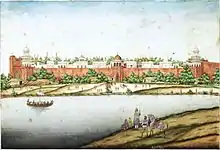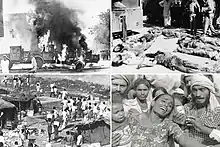| Part of a series on |
| Sikhism |
|---|
 |
Guru Nanak founded the Sikh faith in the Punjab region of the northern part of the Indian subcontinent in the end of fifteenth century. He was first of the ten Sikh Gurus. The tenth, Guru Gobind Singh, formalised its practices on 13 April 1699.[1] He baptised five Sikh people from different parts of India, with different social backgrounds, to form the Khalsa. Those five Beloved Ones, the Pañj Piārē, then baptised him into the Khalsa fold.[2] This gives the order of Khalsa a history of around 500 years. Historical theory and analysis suggests that Sikhism came into existence during the early Medieval period of the Bhakti movement and also after repeated invasions by Muslim rulers upon the Hindu community during Mughal rule, which lasted between (1526–1857 A.D) especially in the region of North India.[3][4]
The history of the Sikh faith is closely associated with the history of Punjab and the socio-political situation in the north-west of the Indian subcontinent during the 17th century. From the rule of India by the Mughal Emperor Jahangir (r. 1605–1627), Sikhism came into conflict with Mughal laws, because they were affecting political successions of Mughals while cherishing Sufi saints from Islam. Mughal rulers killed many prominent Sikhs for refusing to obey their orders,[5] and for opposing the persecution of Sikhs.[6] Of the total ten Sikh gurus,[7][8][9][10][11] two, Guru Arjan and Guru Tegh Bahadur, were tortured and executed,[12][13] and close kin of several gurus (such as the seven and nine-year old sons of Guru Gobind Singh), were brutally killed,[14][15] along with numerous other main revered figures of Sikhism (such as Banda Bahadur (1716), Bhai Mati Das, Bhai Sati Das and Bhai Dayala), who were also tortured and killed[11][14][15] by Mughal rulers for refusing their orders,[5][7][15][14] and for opposing the persecution of Sikhs and Hindus.[6][13][8][11] Subsequently, Sikhism militarised itself to oppose Mughal hegemony. The emergence of the Sikh Confederacy under the misls and Sikh Empire under the reign of the Maharajah Ranjit Singh (r. 1792–1839) was characterised by religious tolerance and pluralism with Christians, Muslims and Hindus in positions of power. The establishment of the Sikh Empire in 1799 is commonly considered the zenith of Sikhism in the political sphere,[16] during its existence (from 1799 to 1849) the Sikh Empire came to include Kashmir, Ladakh, and Peshawar. A number of Hindu and Muslim peasants converted to Sikhism.[17] Hari Singh Nalwa, the Commander-in-chief of the Sikh army along the northwest Frontier from 1825 to 1837, took the boundary of the Sikh Empire to the very mouth of the Khyber Pass. The Sikh Empire's secular administration integrated innovative military, economic and governmental reforms.
Sikh organizations, including the Chief Khalsa Dewan and Shiromani Akali Dal led by Master Tara Singh, strongly opposed the partition of India, viewing the possibility of the creation of Pakistan as inviting persecution.[18] The months leading up to the partition of India in 1947, saw heavy conflict in the Punjab between Sikhs and Muslims, which saw the effective religious migration of Punjabi Sikhs and Hindus from West Punjab and organized ethnic cleansing of Punjabi Muslims from East Punjab.[19] Currently, most Sikhs live in the Indian state of Punjab, where they formed about 60 percent of the state population.[20]
Early Modern (1469 CE –1708 CE)
Guru Nanak

Guru Nanak (1469–1539), founder of Sikhism, was born to Mehta Kalu and Mata Tripta, in the village of Talwandi, now called Nankana Sahib, near Lahore.[21] His father, named Mehta Kalu, was a Patwari, an accountant of land revenue in the government. Nanak's mother was Mata Tripta, and he had one older sister, Bibi Nanki.
From an early age, Guru Nanak seemed to have acquired a questioning and enquiring mind and refused as a child to wear the ritualistic sacred thread called a janeu and instead said that he would wear the true name of God in his heart as protection, as the thread which could be broken, be soiled, burnt or lost could not offer any security at all. From early childhood, Bibi Nanki saw in her brother the Light of God but she did not reveal this secret to anyone. She is known as the first disciple of Guru Nanak.
Even as a boy, his desire to explore the mysteries of life eventually led him to leave home. Nanak married Sulakhni, daughter of Moolchand Chona, a trader from Batala, and they had two sons, Sri Chand and Lakhmi Chand.
His brother-in-law, Jai Ram, the husband of his sister Nanki, obtained a job for him in Sultanpur as the manager of the government granary. One morning, when he was twenty-eight, Guru Nanak went as usual down to the river to bathe and meditate. It was said that he was gone for three days. When he reappeared, it is said he was "filled with the spirit of God". His first words after his re-emergence were: "There is no Hindu, there is no Muslim". With this secular principle he began his missionary work.[22] He made four distinct major journeys, in the four different directions, which are called Udasis, spanning many thousands of kilometres, preaching the message of God.[21]
Guru Nanak spent the final years of his life in Kartarpur where Langar free blessed food was available. The food would be partaken of by Hindus, rich, poor, both high and so-called low castes. Guru Nanak worked in the fields and earned his livelihood. After appointing Bhai Lehna as the new Sikh Guru, on 22 September 1539, aged 70, Guru Nanak died.
Guru Angad

In 1538, Guru Nanak chose Lehna, his disciple, as a successor to the Guruship rather than one of his sons.[22] Bhai Lehna was named Guru Angad and became the successor of Guru Nanak. Bhai Lehna was born in the village of Harike in Ferozepur district in Punjab, on 31 March 1504. He was the son of a small trader named Pheru. His mother's name was Mata Ramo (also known as Mata Sabhirai, Mansa Devi, Daya Kaur). Baba Narayan Das Trehan was his grandfather, whose ancestral house was at Matte-di-Sarai near Muktsar.
Under the influence of his mother, Bhai Lehna began to worship Durga (A Hindu Goddess). He used to lead a group of Hindu worshippers to Jwalamukhi Temple every year. He married Mata Khivi in January 1520 and had two sons, (Dasu and Datu), and two daughters (Amro and Anokhi). The whole Pheru family had to leave their ancestral village because of the ransacking by the Mughal and Baloch military who had come with Emperor Babur. After this, the family settled at the village of Khadur Sahib by the River Beas, near Tarn Taran Sahib, a small town about 25 km from Amritsar city.
One day, Bhai Lehna heard the recitation of a hymn of Guru Nanak from Bhai Jodha (a Sikh of Guru Nanak Sahib) who was in Khadur Sahib. He was thrilled and decided to proceed to Kartarpur to have an audience (darshan) with Guru Nanak. So while on the annual pilgrimage to Jwalamukhi Temple, Bhai Lehna left his journey to visit Kartarpur and see Baba Nanak. His very first meeting with Guru Nanak completely transformed him. He renounced the worship of the Hindu Goddess, dedicated himself to the service of Guru Nanak and so became his disciple, (his Sikh), and began to live in Kartarpur.
His devotion and service (Sewa) to Guru Nanak and his holy mission was so great that he was instated as the Second Nanak on 7 September 1539 by Guru Nanak. Earlier Guru Nanak tested him in various ways and found an embodiment of obedience and service in him. He spent six or seven years in the service of Guru Nanak at Kartarpur.
When Guru Nanak died on 22 September 1539, Guru Angad left Kartarpur for the village of Khadur Sahib (near Goindwal Sahib). He carried forward the principles of Guru Nanak both in letter and spirit. Yogis and Saints of different sects visited him and held detailed discussions about Sikhism with him.
Guru Angad introduced a new alphabet known as Gurmukhi Script, modifying the old Punjabi script's characters. Soon, this script became very popular and started to be used by the people in general. He took great interest in the education of children by opening many schools for their instruction and thus increased the number of literate people. For the youth, he started the tradition of Mall Akhara, where physical, as well as spiritual exercises, were held. He collected the facts about Guru Nanak's life from Bhai Bala and wrote the first biography of Guru Nanak. He also wrote 63 Saloks (stanzas), which are included in the Guru Granth Sahib. He popularized and expanded the institution of Guru ka Langar that had been started by Guru Nanak.
Guru Angad travelled widely and visited all important religious places and centres established by Guru Nanak for the preaching of Sikhism. He also established hundreds of new Centres of Sikhism (Sikh religious Institutions) and thus strengthened the base of Sikhism. The period of his Guruship was the most crucial one. The Sikh community had moved from having a founder to a succession of Gurus and the infrastructure of Sikh society was strengthened and crystallised – from being an infant, Sikhism had moved to be a young child and ready to face the dangers that were around.
Guru Amar Das

Guru Amar Das became the third Sikh guru in 1552 at the age of 73. Goindwal became an important centre for Sikhism during the Guruship of Guru Amar Das. He continued to preach the principle of equality for women, the prohibition of Sati and the practise of Langar.[23] In 1567, Emperor Akbar sat with the ordinary and poor people of Punjab to have Langar. Guru Amar Das also trained 140 apostles, of which 52 were women, to manage the rapid expansion of the religion.[24] Before he died in 1574 aged 95, he appointed his son-in-law Jetha as the fourth Sikh Guru.
It is recorded that before becoming a Sikh, Bhai Amar Das, as he was known at the time, was a very religious Vaishanavite Hindu who spent most of his life performing all of the ritual pilgrimages and fasts of a devout Hindu. One day, Bhai Amar Das heard some hymns of Guru Nanak being sung by Bibi Amro, the daughter of Guru Angad, the second Sikh Guru. Bibi Amro was married to Bhai Amar Das' brother, Bhai Manak Chand's son who was called Bhai Jasso. Bhai Amar Das was so impressed and moved by these Shabads that he immediately decided to go to see Guru Angad at Khadur Sahib. It is recorded that this event took place when Amar Das was 61 years old.
In 1535, upon meeting Guru Angad, Amar Das was so touched by the Guru's message that he became a devout Sikh. Soon he became involved in Sewa (Service) to the Guru and the Community. Under the impact of Guru Angad and the teachings of the Gurus, Bhai Amar Das became a devout Sikh. He adopted Guru as his spiritual guide (Guru). Amar Das began to live at Khadur Sahib, where he used to rise early in the morning and bring water from the Beas River for the Guru's bath; he would wash the Guru's clothes and fetch wood from the jungle for 'Guru ka Langar'. He was so dedicated to Sewa and the Guru and had completely extinguished pride and was totally lost in this commitment that he was considered an old man who had no interest in life; he was dubbed Amru, and generally forsaken.
However, as a result of Amar Das' commitment to Sikh principles, dedicated service, and devotion to the Sikh cause, Guru Angad Sahib appointed Bhai Amar Das as the third Nanak in March 1552 at the age of 73. He established his headquarters in the newly built town of Goindwal, which Guru Angad had established.
Soon large numbers of Sikhs started flocking to Goindwal to see the new Guru. Here, Guru Amar Das propagated the Sikh faith in a vigorous, systematic and planned manner. He divided the Sikh Sangat area into 22 preaching centres or Manjis, each under the charge of a devout Sikh. He himself visited and sent Sikh missionaries to different parts of India to spread Sikhism.
Guru Amar Das was impressed with Bhai Gurdas' thorough knowledge of Hindi and Sanskrit and the Hindu scriptures. Following the tradition of sending out Masands across the country, Guru Amar Das deputed Bhai Gurdas to Agra to spread the gospel of Sikhism. Before leaving, Guru Amar Das prescribed the following routine for Sikhs:
He who calls himself a Sikh of the True Guru, He must get up in the morning and say his prayers. He must rise in the early hours and bathe in the holy tank. He must meditate on God as advised by the Guru. And rid him of the afflictions of sins and evil. As the day dawns, he should recite scriptures, and repeat God's name in every activity. He to whom the Guru takes kindly is shown the path. Nanak! I seek the dust of the feet of the Guru's Sikh who himself remembers God and makes others remember Him. (Gauri)
Guru Ji strengthened the tradition of 'Guru ka Langar' and made it compulsory for the visitor to the Guru to eat first, saying that 'Pehle Pangat Phir Sangat' (first visit the Langar then go to the Guru). Once Mughal emperor Akbar came to see the Guru and he had to eat the coarse rice in the Langar before he could have an audience with the Guru. The emperor was so impressed with this system that he expressed his desire to grant some royal property for 'Guru ka Langar', but the Guru declined it with respect.
He introduced new birth, marriage, and death ceremonies. Thus he raised the status of women and protected the rights of female infants who were killed without question as they were deemed to have no status. These teachings were met with stiff resistance from the Orthodox Hindus.
Guru Amar Das not only preached the equality of people irrespective of their caste but also fostered the idea of women's equality. He preached strongly against the practice of Sati (a Hindu wife burning on her husband's funeral pyre). Guru Amar Das also disapproved of a young widow remaining unmarried for the rest of her life.
Guru Amar Das constructed "Baoli" at Goindwal Sahib having eighty-four steps and made it a Sikh pilgrimage centre for the first time in the history of Sikhism. He reproduced more copies of the hymns of Guru Nanak and Guru Angad. He also composed 869 (according to some chronicles these were 709) verses (stanzas) including Anand Sahib, and then later on Guru Arjan (fifth Guru) made all the Shabads part of Guru Granth Sahib.
When the time came for the Guru's younger daughter Bibi Bhani to marry, he selected a pious and diligent young follower of his called Jetha from Lahore. Jetha had come to visit the Guru with a party of pilgrims from Lahore and had become so enchanted by the Guru's teachings that he had decided to settle in Goindwal. Here he earned a livelihood selling boiled chickpeas and would regularly attend the services of Guru Amar Das in his spare time.
Guru Amar Das did not consider anyone of his sons fit for Guruship and chose instead his son-in-law (Guru) Ram Das to succeed him. Guru Amar Das Sahib at the age of 95 died on 1 September 1574 at Goindwal in District Amritsar, after giving the responsibility of Guruship to the Fourth Nanak, Guru Ram Das.
Guru Ram Das

Guru Ram Das (Punjabi: ਗੁਰੂ ਰਾਮ ਦਾਸ) (Born in Lahore, Punjab, Pakistan on 24 September 1534 – 1 September 1581, Amritsar, Punjab, India) was the fourth of the Ten Gurus of Sikhism, and he became Guru on 30 August 1574, following in the footsteps of Guru Amar Das. He was born in Lahore to a Sodhi family of the Khatri clan. His father was Hari Das and his mother Anup Devi, and his name was Jetha, meaning 'first born'. His wife was Bibi Bhani, the younger daughter of Guru Amar Das, the third guru of the Sikhs. They had three sons: Prithi Chand, Mahan dev, and Arjan Dev.
As a Guru one of his main contributions to Sikhism was organising the structure of Sikh society. Additionally, he was the author of Laava, the hymns of the Marriage Rites, the designer of the Harmandir Sahib, and the planner and creator of the township of Ramdaspur (later Amritsar).
A hymn by Guru Ram Das from Ang 305 of the Guru Granth Sahib: "One who calls himself a Sikh of the True Guru shall get up early morning and meditate on the Lord's Name. Make effort regularly to cleanse, bathe and dip in the ambrosial pool. Upon Guru's instructions, chant Har, Har singing which, all misdeeds, sins, and pains shall go away."
Guru Ram Das nominated Guru Arjan, his youngest son, as the next Guru of the Sikhs.
Guru Arjan Dev
_depicting_Guru_Arjan_overseeing_the_construction_of_the_Golden_Temple_(Harmandir_Sahib_or_Darbar_Sahib)_at_Amritsar_(then_Ramdaspur)%252C_located_in_Gurdwara_Lachi_Ber.jpg.webp)
In 1581, Guru Arjan — the youngest son of the fourth guru — became the Fifth Guru of the Sikhs. In addition to being responsible for building the Golden Temple, he prepared the Sikh Sacred text and his personal addition of some 2,000 plus hymns in the Gurū Granth Sāhib. He compiled and composed the most hymns. He even added many Sufi Saints, Bhagats, Bhatts and Gursikhs verses such as Sheik Farid, Sant Kabir, Bhagat Namdev and Bhai Mardana.
In 1604 he installed the Ādi Granth for the first time as the Holy Book of the Sikhs. He is known as Shaheedan-De-Saraaj or Crown of Martyrs because he gave Jehangir's son langer and made him hear Kirtan, his son, Khusrau, was revolting against Jehangir. Guru Arjan Dev Ji refused to convert to Islam when he was given the choice.[22]
Guru Hargobind
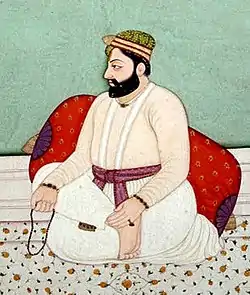
Guru Hargobind became the sixth guru of the Sikhs. He carried two swords — one for Spiritual reasons and one for temporal (worldly) reasons.[25] From this point onward, the Sikhs became a military force and always had a trained fighting force to defend their independence, establishing the Akal Sena.
Guru Hargobind fixed two Nishan Sahibs at Akal Bunga in front of the Akal Takht. One flag is towards the Harmandir Sahib and the other shorter flag is towards Akal Takht. The first represents the reins of the spiritual authority while the later represents temporal power stating temporal power should be under the reins of the spiritual authority.
Guru Har Rai
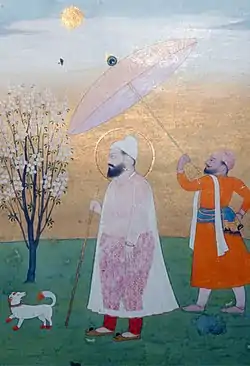
Guru Har Rai (Punjabi: ਗੁਰੂ ਹਰਿ ਰਾਇ) (26 February 1630 – 6 October 1661) was the seventh of the ten Gurus of Sikhism, becoming Guru on 8 March 1644, following in the footsteps of his grandfather, Guru Har Gobind, who was the sixth guru. Before Guru Har Rai died, he nominated Guru Har Krishan, his youngest son, as the next Guru of the Sikhs.
As a very young child, he got disturbed by the suffering of a flower damaged by his robe in passing. Though such feelings are common with children, Guru Har Rai would throughout his life be noted for his compassion for life and living things. His grandfather, who was famed as an avid hunter, is said to have saved the Moghul Emperor Jahangir's life during a tiger's attack. Guru Har Rai continued the hunting till the age 31, Guru followed the tradition of his grandfather, but he would allow no animals to be killed on his grand Shikars. The Guru instead captured the animal and added it to his zoo. He made several tours to the Malwa and Doaba regions of Punjab.
His son, Ram Rai, seeking to assuage concerns of Aurangzeb over one line in Guru Nanak's verse (Mitti Mussalmaan ki paerrai pai kumihaar) suggested that the word Mussalman was a mistake on the copyist's part, therefore distorting Bani. The Guru refused to meet with him again. The Guru is believed to have said, "Ram Rai, you have disobeyed my order and sinned. I will never see you again on account of your infidelity." It was also reported to the Guru that Ram Rai had also worked miracles in the Mughal's court against his father's direct instructions. Sikhs are constrained by their Gurus to not believe in magic and myth or miracles. Just before his death at age 31, Guru Har Rai passed the Gaddi of Nanak on to his younger son, the five-year-old – Guru Har Krishan.
Guru Har Rai was the son of Baba Gurdita and Mata Nihal Kaur (also known as Mata Ananti Ji). Baba Gurdita was the son of the sixth Guru, Guru Hargobind. Guru Har Rai married Mata Kishan Kaur (sometimes also referred to as Sulakhni), daughter of Sri Daya Ram of Anoopshahr (Bulandshahr) in Uttar Pradesh on Har Sudi 3, Samvat 1697. Guru Har Rai had two sons: Baba Ram Rai and Sri Har Krishan.
Although Guru Har Rai was a man of peace, he never disbanded the armed Sikh Warriors (Saint Soldiers), who earlier were maintained by his grandfather, Guru Hargobind. He always boosted the military spirit of the Sikhs, but he never himself indulged in any direct political and armed controversy with the contemporary Mughal Empire. Once, Dara Shikoh (the eldest son of emperor Shah Jahan), came to Guru Har Rai asking for help in the war of succession with his brother, the murderous Aurangzeb. The Guru had promised his grandfather to use the Sikh Cavalry only in defense. Nevertheless, he helped him to escape safely from the bloody hands of Aurangzeb's armed forces by having his Sikh warriors hide all the ferry boats at the river crossing used by Dara Shikoh in his escape.
Guru Har Krishan

Guru Har Krishan born in Kirat Pur, Ropar (Punjabi: ਗੁਰੂ ਹਰਿ ਕ੍ਰਿਸ਼ਨ) (7 July 1656 – 30 March 1664) was the eighth of the Ten Gurus of Sikhism, becoming the Guru on 7 October 1661, following in the footsteps of his father, Guru Har Rai. Before Har Krishan died of complications of Smallpox, he nominated his granduncle, Guru Teg Bahadur, as the next Guru of the Sikhs. The following is a summary of the main highlights of his short life:
Sri Guru Harkrishan Ji was the epitome of sensibility, generosity, and courage. There is a famous incident from an early age. Once on the way to Delhi from Punjab he met an arrogant Brahmin Pundit called Lal Chand in Panjokhara town. The Pundit asked him to recite Salokas from the Geeta since his name was similar to that of Lord Krishna. Guru Ji invited a mute person called Chhajju Mehra and placed his stick on his head. He immediately started interpreting salokas from the Geeta. Everybody around was dumbstruck. Lal Chand's arrogance too was shattered and he asked for Guru Ji's forgiveness.
When Har Krishan stayed in Delhi there was a smallpox epidemic and many people were dying. According to Sikh history at Har Krishan's blessing, the lake at Bangla Sahib provided cure for thousands. Gurdwara Bangla Sahib was constructed in the Guru's memory. This is where he stayed during his visit to Delhi. Gurdwara Bala Sahib was built in south Delhi besides the bank of the river Yamuna, where Har Krishan was cremated at the age of about 7 years and 8 months. Guru Har Krishan was the youngest Guru at only 7 years of age. He did not make any contributions to Gurbani.
Guru Tegh Bahadur
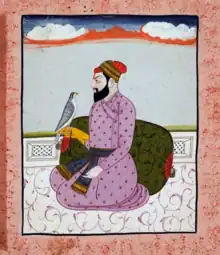
Guru Tegh Bahadur was the ninth of the Sikh Gurus. The eight Sikh Guru, Guru Har Krishan, nominated him, his grand-uncle as the next Guru before he died. Guru Tegh Bahadur was actually the son of the sixth Sikh Guru, Guru Hargobind.
He sacrificed himself to protect Hindus. Aurungzeb was forcibly converting Hindus to Muslims. Hindus from Kashmir came to Guru Teg Bahadur for protection and requested for assistance. Guru asked them to tell Aurungzeb that if he will be able to convert Guru Teg Bahadur to Islam then they all become Muslim. He was asked by Aurungzeb, the Mughal emperor, under coercion by conservative Naqshbandi clerics, to convert to Islam or to sacrifice himself. The exact place where he died is in front of the Red Fort in Delhi (Lal Qila) and the gurdwara is called Sisganj.[26] This marked a turning point for Sikhism. His successor, Guru Gobind Singh further militarised his followers.
While, Bhai Mati Das along with his younger brother Bhai Sati Das were martyrs of early Sikh history. Bhai Mati Das, Bhai Dayala, and Bhai Sati Das were executed at a kotwali (police-station) in the Chandni Chowk area of Delhi, under the express orders of Emperor Aurangzeb just before the martyrdom of Guru Tegh Bahadur. Bhai Mati Das was executed by being bound between two pillars and cut in two.[27]
Guru Gobind Singh
Birth and Childhood
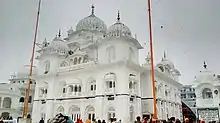
Guru Gobind Singh was the tenth guru of Sikhs. He was born in 1666 at Patna (Capital of Bihar, India).and did his basic schooling there. Along with the religious scriptures, he also studied the Bihari language at Patna. His Uncle, Bhai Kripal, trained him in archery and swordsmanship and soon he became a great marksman. When Guru Tegh Bahadur returned from Dhaka (now Bangladesh‘s Capital) to Patna he saw his five years old child for the first time, and kissed and embraced his divine boy. The Guru blossomed under the spiritual guidance of his father, but it was short-lived since Guru Tegh bahadur had to leave Patna for Anandpur.
Gobind Rai, as he was called then, was beloved of many people in Patna including a large number of Muslims. The child had a charming personality which attracted everyone he met, even for a short while. When he was six years old he had learnt Hindi, Marathi and Gurumukhi. He was a very bold and courageous boy, and had all the qualities of a great man and a natural leader.
A Raja's childless Queen had developed special fondness for the young Guru Gobind Singh, who, too, often came here to sit in the Queen's lap giving her immense delight and spiritual solace. She fed the Child Gobind and his playmates, at his demand, with boiled and salted gram.
In Kashmir

In 1675 Pundits from Kashmir in India came to Anandpur Sahib pleading to Guru Teg Bahadur (father of Guru Gobind Singh) about Aurangzeb forcing them to convert to Islam. Guru Teg Bahadur told them that martyrdom of a great man was needed. His son, Guru Gobind Singh said "Who could be greater than you", to his father. Guru Teg Bahadur told pundits to tell Aurangzeb's men that if Guru Teg Bahadur will become Muslim, they all will.
Stay at Paotana Sahib and Anandpur Sahib
After Guru Tegh Bahadur ji's martyrdom Guru Gobind Singh Ji created many poems compositions and letters, including Zafarnama, Ugardandis, Lakhi Jungle Khalsa, Hikayatan, Akal Ustat, Japji Sahib etc., these were incorporated into the Dasam Granth and Sarbloh Granth respectively. He stayed at Anandpur Sahib for most of his life and the Hindu Hill Chieftains were jealous of his riches so the Kingdoms of Kahlur, Bilaspur, Garhwal and common Hindus made an alliance to fight him. He and the kingdom of Una allied and won the Battle of Bhangani. The even more Himachali states allied and still lost. This showed the Guruji's influence and military strength in the area.
Mughal-Sikh Wars and Death of the Sahibzadas

They allied with Wazir Khan of Sirhind and the Subedar of Lahore and together they still lost and one day Guruji started retreating from Anandpur Sahib and he got separated with his two sons aged 5 and 9 due to the cold Sirsa River. He entrusted his Brahmin cook, Gangu Brahmin, to take care of them but he sold them to Wazir Khan.[28][29] In the meantime Aurangzeb dispatched 50,000-75,000 troops to attack the Guruji. after he sent his elder sons and 42 others to fight only 17,000 Mughals came back alive, his elder sons died on the battlefield with bravery and honour. The younger sons and their grandmother remained trapped in the same week that their brothers died. Wazir Khan said that he would give them riches if they convert and immurement if they do not, they chose death, till now Sahibzada Fateh Singh is the youngest Martyr in the history of the World. Guru Gobind Singh Ji sent his letter of victory to Aurangzeb and they signed a treaty. Later when Aurangzeb Died and the Guru was in Rajputana there was a war of succession between Muhammad Azam Shah and Bahadur Shah I and Guru Gobind Singh Ji sided with Bahadur Shah I who was secular in his views. On his way to Aurangabad he was stabbed three times in his lungs and killed the assassin. He survived for three more weeks and but later died from his wounds.

Shortly before passing away Guru Gobind Singh ordered that the Guru Granth Sahib (the Sikh Holy Scripture), would be the ultimate spiritual authority for the Sikhs and temporal authority would be vested in the Khalsa Panth – the Sikh Nation. The first Sikh Holy Scripture was compiled and edited by the Fifth Guru, Guru Arjan in AD 1604, although some of the earlier gurus are also known to have documented their revelations. This is one of the few scriptures in the world that has been compiled by the founders of faith during their own lifetime. The Guru Granth Sahib is particularly unique among sacred texts in that it is written in Gurmukhi script but contains many languages including Punjabi, Hindustani, Sanskrit, Bhojpuri, Arabic and Persian. Sikhs consider the Guru Granth Sahib the last, perpetual living guru.
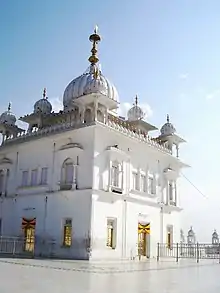 Keshgarh Sahib Gurudwara at Anandpur Sahib, Punjab, the birthplace of Khalsa.
Keshgarh Sahib Gurudwara at Anandpur Sahib, Punjab, the birthplace of Khalsa. An inscription naming the five members of the Khalsa Panth, at Takht Keshgarh Sahib, the birthplace of Khalsa on Baisakh 1, 1756 Vikram Samvat.
An inscription naming the five members of the Khalsa Panth, at Takht Keshgarh Sahib, the birthplace of Khalsa on Baisakh 1, 1756 Vikram Samvat.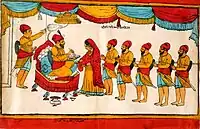 The creation of the Khalsa; initiated by Guru Gobind Singh, the tenth Sikh Guru.
The creation of the Khalsa; initiated by Guru Gobind Singh, the tenth Sikh Guru. Guru Gobind Singh ji on march to Aurangabad
Guru Gobind Singh ji on march to Aurangabad One of the two Sikh Nishan Sahibs
One of the two Sikh Nishan Sahibs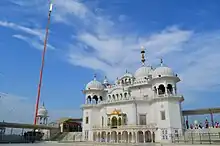 Anandpur Sahib where the Khalsa was formed
Anandpur Sahib where the Khalsa was formed
Late Modern Age (1708–1748 CE)
Banda Singh Bahadur

Banda Singh Bahadur was chosen to lead the Sikhs by Guru Gobind Singh.[30] He was successful in setting up a Sikh Empire that spread from Uttar Pradesh to Punjab. He fought the Mughal state tyranny and gave the common people of Punjab courage, equality, and rights.[31][32] On his way to Punjab, Banda Singh punished robbers and other criminal elements making him popular with the people.[33] Banda Singh inspired the minds of the non-Muslim people, who came to look upon the Sikhs as defenders of their faith and country.[34] Banda Singh possessed no army but Guru Gobind Singh in a Hukamnama called to the people of Punjab to take arms under the leadership of Banda Singh overthrow and destroy the oppressive Mughal rulers,[35] oppressed Muslims and oppressed Hindus also joined him in the popular revolt against the tyrants.[36]
Banda Singh Bahadur camped in Khar Khoda, near Sonipat from there he took over Sonipat and Kaithal.[37] In 1709 Banda Singh captured the Mughal city of Samana with the help of revolting oppressed Hindu and common folk, killing about 10,000 Muslims.[38][39] Samana which was famous for minting coins, with this treasury the Sikhs became financially stable. The Sikhs soon took over Saraswati Nagar[40] and Sadhora (near Jagadhri).[41] The Sikhs then captured the Cis-Sutlej areas of Punjab including Ghurham, Kapori, Banoor, Malerkotla, and Nahan. The Sikhs captured Sirhind in 1710 and killed the Governor of Sirhind, Wazir Khan who was responsible for the death of the two youngest sons of Guru Gobind Singh at Sirhind. Becoming the ruler of Sirhind Banda Singh gave order to give ownership of the land to the farmers and let them live in dignity and self-respect.[42] Petty officials were also satisfied with the change. Dindar Khan, an official of the nearby village, took Amrit and became Dinder Singh and the newspaper writer of Sirhind, Mir Nasir-ud-din, became Mir Nasir Singh[43]
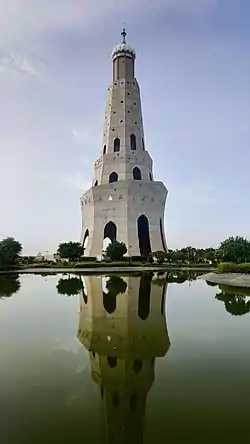
Banda Singh developed the village of Mukhlisgarh, and made it his capital He then renamed the city it to Lohgarh (fortress of steel) where he issued his own mint.[44] The coin described Lohgarh: "Struck in the City of Peace, illustrating the beauty of civic life, and the ornament of the blessed throne." He briefly established a state in Punjab for half a year. Banda Singh sent Sikhs to the Uttar Pradesh and Sikhs took over Saharanpur, Jalalabad, Saharanpur, and other areas nearby bringing relief to the repressed population.[45] In the regions of Jalandhar and Amritsar, the Sikhs started fighting for the rights of the people. They used their newly established power to remove corrupt officials and replace them with honest ones.[45]
Banda Singh is known to have abolished or halted the Zamindari system in time he was active and gave the farmers proprietorship of their own land.[46] It seems that all classes of government officers were addicted to extortion and corruption and the whole system of regulatory and order was subverted.[47] Local tradition recalls that the people from the neighborhood of Sadaura came to Banda Singh complaining of the iniquities practices by their landlords. Banda Singh ordered Baj Singh to open fire on them. The people were astonished at the strange reply to their representation, and asked him what he meant. He told them that they deserved no better treatment when being thousands in number they still allowed themselves to be cowed down by a handful of Zamindars.[48]
The rule of the Sikhs over the entire Punjab east of Lahore obstructed the communication between Delhi and Lahore, the capital of Punjab, and this worried Mughal Emperor Bahadur Shah He gave up his plan to subdue rebels in Rajasthan and marched towards Punjab.[49] The entire Imperial force was organised to defeat and kill Banda Singh.[50] All the generals were directed to join the Emperor’s army. To ensure that there were no Sikh agents in the army camps, an order was issued on 29 August 1710 to all Hindus to shave off their beards.[51]
Banda Singh was in Uttar Pradesh when the Moghal army under the orders of Munim Khan[52] marched to Sirhind and before the return of Banda Singh, they had already taken Sirhind and the areas around it. The Sikhs therefore moved to Lohgarh for their final battle. The Sikhs defeated the army but reinforcements were called and they laid siege on the fort with 60,000 troops.[53][54] Gulab Singh dressed himself in the garments of Banda Singh and seated himself in his place.[55] Banda Singh left the fort at night and went to a secret place in the hills and Chamba forests. The failure of the army to kill or catch Banda Singh shocked Emperor, Bahadur Shah and On 10 December 1710 he ordered that wherever a Sikh was found, he should be murdered.[56] The Emperor became mentally disturbed and died on 18 February 1712.[57]
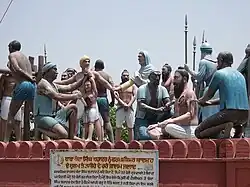
Banda Singh Bahadur wrote Hukamnamas to the Sikhs telling them to get themselves reorganised and join him at once.[58] In 1711 the Sikhs gathered near Kiratpur Sahib and defeated Raja Bhim Chand,[59] who was responsible for organising all the Hill Rajas against Guru Gobind Singh and instigating battles with him. After Bhim Chand’s dead the other Hill Rajas accepted their subordinate status and paid revenues to Banda Singh. While Bahadur Shah's 4 sons were killing themselves for the throne of the Mughal Emperor[60] Banda Singh Bahadur recaptured Sadhura and Lohgarh. Farrukh Siyar, the next Moghal Emperor, appointed Abdus Samad Khan as the governor of Lahore and Zakaria Khan, Abdus Samad Khan's son, the Faujdar of Jammu.[61] In 1713 the Sikhs left Lohgarh and Sadhura and went to the remote hills of Jammu and where they built Dera Baba Banda Singh.[62] During this time Sikhs were being hunted down especially by pathans in the Gurdaspur region.[63] Banda Singh came out and captured Kalanaur and Batala[64] which rebuked Farrukh Siyar to issue Mughal and Hindu officials and chiefs to proceed with their troops to Lahore to reinforce his army.[65]
In March 1715, Banda Singh Bahadur was in the village of Gurdas Nangal, Gurdaspur, Punjab, when the army under the rule of Samad Khan,[66] the Mogual king of Delhi laid siege to the Sikh forces.[67] The Sikhs fought and defended the small fort for eight months.[68] On 7 December 1715 Banda Singh starving soldiers were captured.
Execution
On 7 December 1715 Banda Singh Bahadur[69] was captured from the Gurdas Nangal fort and put in an iron cage and the remaining Sikhs were captured, chained.[70] The Sikhs were brought to Delhi in a procession with the 780 Sikh prisoners, 2,000 Sikh heads hung on spears, and 700 cartloads of heads of slaughtered Sikhs used to terrorise the population.[71][72] They were put in the Delhi fort and pressured to give up their faith and become Muslims.[73] On their firm refusal all of them were ordered to be executed. Every day, 100 Sikhs were brought out of the fort and murdered in public daily,[74] which went on approximately seven days.After 3 months of confinement[75] On 9 June 1716, Banda Singh’s eyes were gouged, his limbs were severed, his skin removed, and then he was killed.[76]
Sikhs retreat to jungles
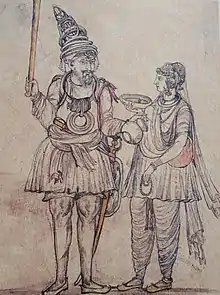
In 1716 Farrukh Siyar, the Mughal Emperor, issued all Sikhs to be converted to Islam or die, an attempt to destroy the power of the Sikhs and to exterminate the community as a whole.[77] A reward was offered for the head of every Sikh.[78] For a time it appeared as if the boast of Farrukh Siyar to wipe out the name of Sikhs from the land was going to be fulfilled. Hundreds of Sikhs were brought in from their villages and executed, and thousands who had joined merely for the sake of booty cut off their hair and went back to the Hindu fold again.[79] Besides these there were some Sikhs who had not yet received the baptism of Guru Gobind Singh, nor did they feel encouraged to do so, as the adoption of the outward symbols meant courting death.
After a few years Adbus Samad Khan, the Governor of Lahore, Punjab and other Mughal officers began to pursue Sikhs less and thus the Sikhs came back to the villages and started going to the Gurdwaras again,[80] which were managed by Udasis when the Sikhs were in hiding. The Sikhs celebrated Bandhi Chorh Diwas and Vaisakhi at Harmandir Sahib. The Khalsa had been split into two major factions Bandia Khalsa and Tat Khalsa and tensions were spewing between the two.
Under the authority of Mata Sundari Bhai Mani Singh become the Jathedar of the Harminder Sahib[81] and a leader of the Sikhs and the Bandia Khalsa and Tat Khalsa joined by Bhai Mani Singh into the Tat Khalsa[82] and after the event from that day the Bandeis assumed a quieter role and practically disappeared from the pages of history. A police post was established at Amritsar to keep a check on the Sikhs. Mani Singh was killed by cutting each of his body joint .[83]
Abdus Samad Khan, was transferred to Multan in 1726, and his more energetic Son, Zakaria Khan, also known as Khan Bahadur,[84] was appointed to take his place as the governor of Lahore. In 1726, Tarra Singh of Wan, a renowned Sikh leader, and his 26 men was killed after Governor Zakaria Khan, sent 2200 horses, 40 zamburaks, 5 elephants and 4 cannons, under the command of his deputy, Momin Khan.[85] The murder of Tarra Singh spread across the Sikhs in Punjab and the Sikhs. Finding no Sikhs around, the government falsely announced in each village with the beat of a drum, that all Sikhs had been eliminated but the common people knew the truth that this was not the case.[86] The Sikhs did not face the army directly, because of their small numbers, but adopted dhai phut guerrilla warfare (hit and run) tactics.
Under the leadership of Nawab Kapoor Singh and Jathedar Darbara Singh, in attempt to weaken their enemy looted many of the Mughals caravans and supplies and for some years no money from revenue could reach the government treasury.[87] When the forces of government tried to punish the outlaws, they were unable to contact them, as the Sikhs did not live in houses or forts, but ran away to their rendezvous in forests or other places difficult to access.
Nawab Kapur Singh
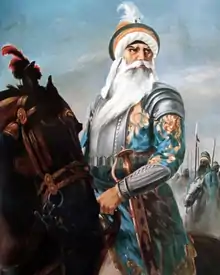
Nawab Kapur Singh was born in 1697 in a village near Sheikhupura in what is today Punjab, Pakistan. He was a volunteer at Darbar Sahib Amritsar. His was cleaning shoes of Sangat that come to pay their respect to Darbar Sahib, work in the kitchen to feed the Sangat. He was given a jagir in 1733 when the Governor of Punjab offered the Sikhs the Nawabship (ownership of an estate) and a valuable royal robe, the Khalsa accepted it all in the name of Kapur Singh.[88] Henceforth, he became known as Nawab Kapur Singh. In 1748 he would organise the early Sikh Misls into the Dal Khalsa (Budda Dal and Tarna Dal).[89]
Nawab Kapur Singh’s father was Chaudhri Daleep Singh as a boy he memorised Gurbani Nitnem and was taught the arts of war.[90] Kapur Singh was attracted to the Khalsa Panth after the execution of Bhai Tara Singh, of the village of Van, in 1726.[91]
Extensive looting of the Mughal government
The Khalsa held a meeting to make plans to respond to the state repression against the people of the region and they decided to take possession of government money and weapons in order to weaken the administration, and to equip themselves to face the everyday attacks.[90] Kapur Singh was assigned to plan and execute these projects.
Information was obtained that money was being transported from Multan to the Lahore treasure; the Khalsa looted the money and took over the arms and horses of the guards.[90] They then took over one lakh rupees from the Kasoor estate treasury going from Kasur to Lahore.[92] Next they captured a caravan from Afghanistan region which resulted in capturing numerous arms and horses.
The Khalsa seized a number of vilayati (Superior Central Asian) horses from Murtaza Khan was going to Delhi in the jungle of Kahna Kachha.[87][93] Some additional war supplies were being taken from Afghanistan to Delhi and Kapur Singh organised an attack to capture them. In another attack, the Khalsa recovered gold and silver which was intended to be carried from Peshawar to Delhi by Jaffar Khan, a royal official.[92]
Government sides with the Khalsa
The Mughal rulers and the commanders alongside the Delhi government lost all hope of defeating the Sikhs through repression and decided to develop another strategy, Zakaria Khan, the Governor of Lahore, went to Delhi where it was decided to befriend the Sikhs and rule in cooperation with them and in 1733 the Delhi rulers withdrew all orders against the Khalsa.[88] The Sikhs were now permitted to own land and to move freely without any state violence against them.[94] To co-operate with the Khalsa Panth, and win the goodwill of the people, the government sent an offer of an estate and Nawabship through a famous Lahore Sikh, Subeg Singh.[95] The Khalsa did not wanted to rule freely and not to be under the rule of a subordinate position. However this offer was eventually accepted and this title was bestowed on Kapur Singh after it was sanctified by the touch of Five Khalsas feet.[96] Thus Kapur Singh became Nawab Kapur Singh. Kapur Singh guided the Sikhs in strengthening themselves and preaching Gurmat to the people. He knew that peace would be short-lived. He encouraged people to freely visit their Gurdwaras and meet their relatives in the villages.[94]
Dal Khalsa

The Khalsa reorganised themselves into two divisions, the younger generation would be part of the Taruna Dal, which provided the main fighting force, while the Sikhs above the age of forty years would be a part of the Budha Dal, which provided the responsibility of the management of Gurdwaras and Gurmat preaching.[97] The Budha Dal would be responsible to keep track of the movements of government forces, plan their defense strategies, and they provide a reserve fighting force for the Taruna Dal.[94]
The following measures were established by Nawab Kapur Singh:[98]
5 Sikh Misls of the Dal Khalsa
The Taruna Dal quickly increased to more than 12,000 recruits and it soon became difficult to manage the house and feeding of such a large number of people at one place.[98] It was then decided to have five divisions of the Dal, each to draw rations from the central stocks and cook its own langar.[99] These five divisions were stationed around the five sarovars (sacred pools) around Amritsar they were Ramsar, Bibeksar, Lachmansar, Kaulsar and Santokhsar.[100] The divisions later became known as Misls and their number increased to eleven. Each took over and ruled a different region of the Punjab. Collectively they called themselves the Sarbat Khalsa.
Preparing Jassa Singh Ahluwalia for leadership
Being the leader of the Khalsa Nawab Kapur Singh was given an additional responsibility by Mata Sundari, the wife of Guru Gobind Singh sent Kapur Singh the young Jassa Singh Ahluwalia and told him that Ahluwalia was like a son to her and that the Nawab should raise him like an ideal Sikh. Ahluwalia under the guidance of Kapur Singh, was given a good education in Gurbani and thorough training in managing the Sikh affairs.[101] Later Jassa Singh Ahluwalia would become an important role in leading the Sikhs to self-rule.
State oppression
In 1735, the rulers of Lahore attacked and repossessed the jagir (estate) given to the Sikhs only two years before[102] however Nawab Kapur Singh in reaction decided the whole Punjab should be taken over by the Sikhs.[103] This decision was taken against heavy odds but was endorsed by the Khalsa and all the Sikhs assured him of their full cooperation in his endeavor for self-rule. Zakariya Khan Bahadur sent roaming squads to hunt and kill the Sikhs. Orders were issued to all administrators down to the village level officials to seek Sikhs, murder them, get them arrested, or report their whereabouts to the governments. One year's wages were offered to anyone who would murder a Sikh and deliver his head to the police station.[101] Rewards were also promised to those who helped arrest Sikhs. Persons providing food or shelter to Sikhs or helping them in any way were severely punished.[104]
This was the period when the Sikhs were sawed into pieces,[105] burnt alive,[106] their heads crushed with hammers[107] and young children were pierced with spears before their mother’s eyes.[108] To keep their morale high, the Sikhs developed their own high-sounding terminologies and slogans:[107] For example. Tree leaves boiled for food were called ‘green dish’; the parched chickpeas were called ‘almonds’; the Babul tree was a ‘rose’; a blind man was a ‘brave man’, getting on the back of a buffalo was ‘riding an elephant’.
The army pursued the Sikhs hiding near the hills and forced them to cross the rivers and seek safety in the Malwa tract.[109] When Kapur Singh reached Patiala he met Maharaja Baba Ala Singh who then took Amrit[110] and Kapur Singh helped him increase the boundaries of his state. In 1736 the Khalsa attacked Sirhind, where the two younger sons of Guru Gobind Singh were killed. The Khalsa took over the city, the took over the treasury and they established the Gurdwaras at the historical places and withdrew.[107] While near Amritsar the government of Lahore sent troops to attack the Sikhs. Kapur Singh entrusted the treasury to Jassa Singh Ahluwalia, while having sufficient amount of Sikhs with him to keep the army engaged. When Jassa Singh was reached a considerable distance the Khalsa safely retreated to Tarn Taran Sahib. Kapur Singh sent messages to the Tauna Dal asking them to help them in the fight. After a day of fighting Kapur Singh from the trenches dug by the Khalsa surprisingly attacked the commanding posts killing three generals alongside many Mughal officers. The Mughal army thus retreated to Lahore.
Zakaria Khan called his advisers to plan another strategy to deal with the Sikhs. It was suggested that the Sikhs should not be allowed to visit the Amrit Sarovar,[111] which was believed to be the fountain of their lives and source of their strength. Strong contingents were posted around the city and all entries to Harmandir Sahib were checked. The Sikhs, however, risking their lives, continued to pay their respects to the holy place and take a dip in the Sarovar (sacred pool) in the dark of the night. When Kapur Singh went to Amritsar he had a fight with Qadi Abdul Rehman. He had declared that Sikhs the so-called lions, would not dare to come to Amritsar and face him. In the ensuing fight Abdul Rehman was killed.[112] When his son tried to save him, he too died. In 1738 Bhai Mani Singh was executed.
Sikhs attack Nader Shah
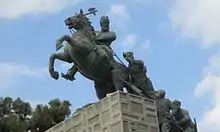
In 1739 Nader Shah of the Turkic Afsharid dynasty invaded and looted the treasury of the Indian subcontinent. Nader Shah killed more than 100,000 people in Delhi and carried off all of the gold and valuables.[113] He added to his caravan hundreds of elephants and horses, along with thousands of young women and Indian artisans.[114] When Kapur Singh learned of this, he decided to warn Nader Shah that if not the local rulers, then the Sikhs would protect the innocent women of Muslims and Hindus from being sold as slaves. While crossing The river Chenab, the Sikhs attacked the rear end of the caravan, freed many of the women, freed the artisans, and recovered part of the treasure.[115]
Sikhs kill Massa Rangar
Massa Ranghar, the Mughal official, had seized Amritsar. While smoking and drinking in the Harmandir Sahib, he watched the dances of nautch girls.[116] The Sikhs who had moved to Bikaner, a desert region, for safety, were outraged to hear of this desecration. In 1740 Sukha Singh and Mehtab Singh, went to Amritsar disguised as revenue collectors.[117] They tied their horses outside, walked straight into the Harmandir Sahib, cut off his head,[118] and took it with them. It was a lesson for the ruler that no tyrant would go unpunished.
Sikhs loot Abdus Samad Khan
Abdus Samad Khan, a senior Mughal royal commander, was sent from Delhi to subdue the Sikhs.[119] Kapur Singh learned of this scheme and planned his own strategy accordingly. As soon as the army was sent out to hunt for the Sikhs, a Jatha of commandos disguised as messengers of Khan went to the armory. The commander there was told that Abdus Samad Khan was holding the Sikhs under siege and wanted him with all his force to go and arrest them. The few guards left behind were then overpowered by the Sikhs, and all the arms and ammunition were looted and brought to the Sikh camp.[120]
Age of Revolution (1748–1799 CE)
Mughals increase persecution
Abdus Samad Khan sent many roaming squads to search for and kill Sikhs. He was responsible for the torture and murder of Bhai Mani Singh,[121] the head Granthi of Harmandir Sahib. Samad Khan was afraid that Sikhs would kill him so he remained far behind the fighting lines.[122] Kapur Singh had a plan to get him. During the battle Kapur Singh ordered his men to retreat drawing the fighting army with them. He then wheeled around and fell upon the rear of the army.[123] Samad Khan and his guards were lying dead on the field within hours. The Punjab governor also took extra precautions for safety against the Sikhs. He started to live in the fort. He would not even dare to visit the mosque outside the fort for prayers.
On the request of the Budha Dal members, Kapur Singh visited Patiala. The sons of Sardar Ala Singh, the founder and Maharajah of the Patiala state, gave him a royal welcome. Kapur Singh subdued all local administrators around Delhi who were not behaving well towards their people.
Zakaria Khan died in 1745. His successor tightened the security around Amritsar. Kapur Singh planned to break the siege of Amritsar. Jassa Singh Ahluwalia was made the commander of the attacking Sikh forces. In 1748, the Sikhs attacked. Jassa Singh Ahluwalia, with his commandos behind him, dashed to the army commander and cut him into two with his sword. The commander's nephew was also killed.
The Khalsa strengthen military developments
The Sikhs built their first fort Ram Rauni at Amritsar in 1748.[124] In December 1748, Governor Mir Mannu had to take his forces outside of Lahore to stop the advance of Ahmad Shah Abdali. The Sikhs quickly overpowered the police defending the station in Lahore and confiscated all of their weapons and released all the prisoners.[125] Nawab Kapur Singh told the sheriff to inform the Governor that, the sheriff of God, the True Emperor, came and did what he was commanded to do. Before the policemen could report the matter to the authorities, or the army could be called in, the Khalsa were already riding their horses back to the forest.[126] Nawab Kapur Singh died in 1753.
Jassa Singh Ahluwalia
Jassa Singh Ahluwalia was born in 1718. His father, Badar Singh, died when Ahluwalia was only four years old.[127] His mother took him to Mata Sundari, the wife of Guru Gobind Singh when Ahluwalia was young.[128][129] Mata Sundri was impressed by his melodious singing of hymns and kept the Ahluwalia near her. Later Jassa Singh Ahluwalia was adopted by Nawab Kapoor Singh,[130] then the leader of the Sikh nation. Ahluwalia followed all Sikh qualities required for a leader Ahluwalia would sing Asa di Var in the morning and it was appreciated by all the Dal Khalsa and Ahluwalia kept busy doing seva (selfless service). He became very popular with the Sikhs. He used to tie his turban in the Mughal fashion as he grew up in Delhi. Ahluwalia learned horseback riding and swordsmanship from expert teachers.[131]
In 1748 Jassa Singh Ahluwalia became the supreme commander of all the Misls.[132] Jassa Singh Ahluwalia was honored with the title of Sultanul Kaum (King of the Nation).[133] Jassa Singh Ahluwalia was the head of the Ahluwalia Misl and then after Nawab Kapoor Singh become the leader of all the Misls jointly called Dal Khalsa. He played a major role In leading the Khalsa to self-rule in Punjab. In 1761 The Dal Khalsa under the leadership of Ahluwalia, would take over Lahore, the capital of Punjab, for the first time.[134] They were the masters of Lahore for a few months and minted their own Nanakshahi rupee coin in the name of 'Guru Nanak – Guru Gobind Singh'.[135]
Chhota Ghalughara (The Lesser Massacre)
In 1746 about seven thousand Sikhs were killed and three thousand to fifteen thousand[136] Sikhs were taken prisoners during by the order of the Mughal Empire when Zakaria Khan, The Governor of Lahore, and Lakhpat Rai, the Divan (Revenue Minister) of Zakaria Khan, sent military squads to kill the Sikhs.[137][138]
Jaspat Rai, a jagirdar (landlord) of the Eminabad area and also the brother of Lakhpat Rai, faced the Sikhs in a battle one of the Sikhs held the tail of his elephant and got on his back from behind and with a quick move, he chopped off his head.[139] Seeing their master killed, the troops fled. Lakhpat Rai, after this incident, committed himself to destroying the Sikhs.[138]
Through March–May 1746, a new wave of violence was started against the Sikhs with all of the resources available to the Mughal government, village officials were ordered to co-operate in the expedition. Zakaria Khan issued the order that no one was to give any help or shelter to Sikhs and warned that severe consequences would be taken against anyone disobeying these orders.[140] Local people were forcibly employed to search for the Sikhs to be killed by the army. Lakhpat Rai ordered Sikh places of worship to be destroyed and their holy books burnt.[141] Information about including Jassa Singh Ahluwalia and a large body of Sikhs were camping in riverbeds in the Gurdaspur district (Kahnuwan tract). Zakaria Khan managed to have 3,000 Sikhs of these Sikhs captured and later got them beheaded in batches at Nakhas (site of the horse market outside the Delhi gate).[142] Sikhs raised a memorial shrine known as the Shahidganj (the treasure house of martyrs) at that place latter.
In 1747, Shah Nawaz took over as Governor of Lahore. To please the Sikhs, Lakhpat Rai was put in prison by the new Governor.[137] Lakhpat Rai received severe punishment and was eventually killed by the Sikhs.
Reclaiming Amritsar
In 1747 Salabat Khan, a newly appointed Mughal commander, placed police around Amritsar and built observation posts to spot and kill Sikhs coming to the Amrit Sarovar for a holy dip.[111] Jassa Singh Ahluwalia and Nawab Kapoor Singh led the Sikhs to Amritsar, and Salabat Khan was killed by Ahluwalia, and his nephew was killed by the arrow of Kapur Singh.[62][143] The Sikhs restored Harmandir Sahib and celebrated their Diwali gathering there.
Reorganisation of the Misls
In 1748 all the Misls joined themselves under one command and on the advice of the aging Jathedar Nawab Kapoor Singh Jassa Singh Ahluwalia was made the supreme leader.[135] They also decided to declare that the Punjab belonged to them and they would be the sovereign rulers of their state. The Sikhs also built their first fort, called Ram Rauni, at Amritsar.
Khalsa side with the Government
Adina Beg, the Faujdar (garrison commander) of Jalandhar, sent a message to the Dal Khalsa chief to cooperate with him in the civil administration, and he wanted a meeting to discuss the matter.[144] This was seen as a trick to disarm the Sikhs and keep them under government control. Jassa Singh Ahluwalia replied that their meeting place would be the battleground and the discussion would be carried out by their swords. Beg attacked the Ram Rauni fort at Amritsar and besieged the Sikhs there.[145] Dewan Kaura Mal advised the Governor to lift the siege and prepare the army to protect the state from the Durrani invader, Ahmed Shah Abdali. Kaura Mal had a part of the revenue of Patti area given to the Sikhs for the improvement and management of Harmandir Sahib, Amritsar.[146]
Kaura Mal had to go to Multan to quell a rebellion there. He asked the Sikhs for help and they agreed to join him. After the victory at Multan, Kaura came to pay his respects to the Darbar Sahib, and offered 11,000 rupees and built Gurdwara Bal-Leela; He also spent 3,000,000 rupees to build a Sarover (holy water) at Nankana Sahib, the birthplace of Guru Nanak Dev.[147] In 1752, Kaura Mall was killed in a battle with Ahmed Shah Abdali and state policy towards the Sikhs quickly changed. Mir Mannu, the Governor, started hunting Sikhs again. He arrested many men and women, put them in prison and tortured them. In November 1753, when he went to kill the Sikhs hiding in the fields, they showered him with a hail of bullets and Mannu fell from the horse and the animal dragged him to death. The Sikhs immediately proceeded to Lahore, attacked the prison, and got all the prisoners released and led them to safety in the forests.[148]
Harmandir Sahib demolished in 1757

In May 1757, the Afghan Durrani general of Ahmad Shah Abdali, Jahan Khan attacked Amritsar with a huge army and the Sikhs because of their small numbers decided to withdraw to the forests. Their fort, Ram Rauni, was demolished, Harmandir Sahib was also demolished, and the army desecrated the Sarovar (Holy water) by filling it with debris and dead animals.[149] Baba Deep Singh made history when he cut through 20,000 Durrani soldiers and reached Harmandir Sahib, Amritsar.[150][151]
The Khalsa gain territory
Adina Beg did not pay revenues to the government so the Governor dismissed him[152] and appointed a new Faujdar (garrison commander) in his place. The army was sent to arrest him and this prompted Adina Beg to request Sikh help. The Sikhs took advantage of the situation and to weaken the government, they fought against the army. One of the commanders was killed by the Sikhs and the other deserted. Later, the Sikhs attacked Jalandhar[153] and thus became the rulers of all the tracts between Sutlej and Beas rivers, called Doaba.[154] Instead of roaming in the forests now they were ruling the cities.
The Sikhs started bringing more areas under their control and realising revenue from them. In 1758, joined by the Mahrattas,[155] they conquered Lahore and arrested many Afghan soldiers who were responsible for filling the Amrit Sarovar with debris a few months earlier. They were brought to Amritsar and made to clean the Sarovar (holy water).[156][157] After the cleaning of the Sarovar, the soldiers were allowed to go home with a warning that they should not do that again.
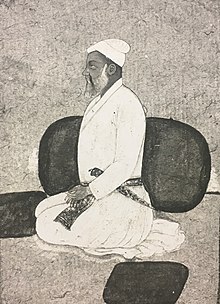
Ahmed Shah Abdali came again in October 1759 to loot Delhi. The Sikhs gave him a good fight and killed more than 2,000 of his soldiers. Instead of getting involved with the Sikhs, he made a rapid advance to Delhi. The Khalsa decided to collect revenues from Lahore to prove to the people that the Sikhs were the rulers of the state. The Governor of Lahore closed the gates of the city and did not come out to fight against them. The Sikhs laid siege to the city. After a week, the Governor agreed to pay 30,000 rupees to the Sikhs.
Ahmed Shah Abdali returned from Delhi in March 1761 with much gold and more than 2,000 girls as prisoners who were to be sold to the Afghans in Kabul. When Abdali was crossing the river Beas, the Sikhs swiftly fell upon them. They freed the women prisoners and escorted them back to their homes. The Sikhs seized Lahore in September 1761, after Abdali returned to Kabul.
The Khalsa minted their coins in the name of Guru Nanak Dev. Sikhs, as rulers of the city, received full cooperation from the people. After becoming the Governor of Lahore, Punjab Jassa Singh Ahluwalia was given the title of Sultan-ul-Kaum (King of the Nation).[158]
Wadda Ghalughara (The Great Massacre)
In the winter of 1762, after losing his loot from Delhi to the Sikhs, The Durrani emperor, Ahmad Shah Abdali brought a big, well equipped army to finish the Sikhs forever. Sikhs were near Ludhiana on their way to the forests and dry areas of the south and Abdali moved from Lahore very quickly and caught the Sikhs totally unprepared.[159] They had their women, children and old people with them. As many as 30,000 Sikhs are said to have been murdered by the army.[160][161] Jassa Singh Ahluwalia himself received about two dozen wounds. Fifty chariots were necessary to transport the heads of the victims to Lahore.[162] The Sikhs call this Wadda Ghalughara (The Great Massacre).
Harmandir Sahib desecrated in 1762
Ahmad Shah Abdali, fearing Sikh retaliation, sent messages that he was willing to assign some areas to the Sikhs to be ruled by them. Jassa Singh Ahluwalia rejected his offers and told him that Sikhs own Punjab and they do not recognise his authority at all. Abdali went to Amritsar and destroyed the Harmandir Sahib again by filling it up with gunpowder hoping to eliminate the source of "life" of the Sikhs.[163][164] While Abdali was demolishing the Harminder Sahib a he was hit on the nose with a brick;[165] later in 1772 Abdali died of cancer from the 'gangrenous ulcer' that consumed his nose.[166] Within a few months the Sikhs attacked Sirhind and moved to Amritsar.
Sikhs retake Lahore
In 1764 the Sikhs shot dead Zain Khan Sirhindi[167] Durrani Governor of Sirhind, and the regions around Sirhind were divided among the Sikh Misldars and money recovered from the treasury were used to rebuild the Harmandir Sahib. Gurdwara Fatehgarh Sahib was built in Sirhind, at the location the two younger sons of Guru Gobind Singh were killed. The Sikhs started striking Govind Shahi coins[168] and in 1765 they took over Lahore again.[169]
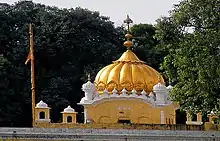
In 1767 when Ahmed Shah Abdali came again he sent messages to the Sikhs for their cooperation. He offered them the governorship of Punjab but was rejected.[154] The Sikhs using repeated guerrilla attacks took away his caravan of 1,000 camels loaded with fruits from Kabul.[170] The Sikhs were again in control of the areas between Sutlej and Ravi. After Abdali’s departure to Kabul, Sikhs crossed the Sutlej and brought Sirhind and other areas right up to Delhi, entire Punjab under their control.[161]
Shah Alam II, the Mughal Emperor of Delhi was staying away in Allahabad, ordered his commander Zabita Khan to fight the Sikhs.[154] Zabita made a truce with them instead[171] and then was dismissed from Alam’s service. Zabita Khan then became a Sikh and was given a new name, Dharam Singh.[172]
Qadi Nur Mohammed, who came to Punjab with Ahmad Shah Abdali and was present during many Sikh battles writes about the Sikhs:[173]
They do not kill a woman, a child, or a coward running away from the fight. They do not rob any person nor do they take away the ornaments of a woman, be she a queen or a slave girl. They commit no adultery, rather they respect the women of even their enemies. They always shun thieves and adulterers and in generosity they surpass Hatim."
Peace in Amritsar
Ahmad Shah Abdali, fearing the Sikhs, did not follow his normal route through Punjab while he returned to Kabul. Jassa Singh Ahluwalia did not add more areas to his Misl. Instead, whenever any wealth or villages came into the hands of the Sikhs he distributed them among the Jathedars of all the Misls. Ahluwalia passed his last years in Amritsar. With the resources available to him, he repaired all the buildings, improved the management of the Gurdwaras, and provided better civic facilities to the residents of Amritsar. He wanted every Sikh to take Amrit before joining the Dal Khalsa.[174]
Ahluwalia died in 1783 and was cremated near Amritsar. There is a city block, Katra Ahluwalia, in Amritsar named after him. This block was assigned to his Misl in honor of his having stayed there and protected the city of Amritsar.
Sardar Jassa Singh Ramgarhia
Jassa Singh Ramgarhia played an active role in Jassa Singh Alhuwalia’s army. He founded the Ramgarhia Misl[175] and played a major role in the battles of the Khalsa Panth. He suffered about two dozen wounds during the Wadda Ghalughara. Jassa Singh Ramgarhia was the son of Giani Bhagwan Singh[175] and was born in 1723. They lived in the village of Ichogil, near Lahore. His grandfather took Amrit during the lifetime of Guru Gobind Singh,[176] and joined him in many battles; he joined the forces of Banda Singh Bahadur. Ramgarhia was the oldest of five brothers. When Ramgarhia was young he had memorised Nitnem hymns and took Amrit.[176]
Award of an Estate
In 1733, Zakaria Khan, the Governor of Punjab, needed help to protect himself from the Iranian invader, Nader Shah. He offered the Sikhs an estate and a royal robe.[177] The Sikhs in the name of Kapur Singh accepted it. After the battle Zakaria Khan gave five villages to the Sikhs in reward for the bravery of Giani Bhagwan Singh, father of Ramgarhia, who died in the battle. Village Vallah was awarded to Ramgarhia,[178] where Ramgarhia gained the administrative experience required to become a Jathedar (leader) of the Sikhs. During this period of peace with the government, the Sikhs built their fort, Ram Rauni, in Amritsar. Zakaria died in 1745 and Mir Mannu became the Governor of Lahore.
Jassa Singh honored as Jassa Singh Ramgarhia

Mir Mannu (Mu'in ul-Mulk), the Governor of Lahore, was worried about the increasing power of the Sikhs so he broke the peace. Mir Mannu also ordered Adina Beg, the Faujdar (garrison commander) of the Jalandhar region, to begin killing the Sikhs.[179] Adina Beg was a very smart politician and wanted the Sikhs to remain involved helping them. In order to develop good relations with the Sikhs, he sent secret messages to them who were living in different places. Jassa Singh Ramgarhia responded and agreed to cooperate with the Faujdar and was made a Commander.[132] This position helped him develop good relations with Divan Kaura Mal at Lahore and assign important posts to the Sikhs in the Jalandhar division.
The Governor of Lahore ordered an attack on Ram Rauni to kill the Sikhs staying in that fort. Adina Beg was required to send his army as well and Jassa Singh, being the commander of the Jalandhar forces, had to join the army to kill the Sikhs in the fort.[180] After about four months of siege, Sikhs ran short of food and supplies in the fort. He contacted the Sikhs inside the fort and joined them. Jassa Singh used the offices of Divan Kaura Mal and had the siege lifted.[181] The fort was strengthened and named Ramgarh; Jassa Singh Ramgarhia, having been designated the Jathedar of the fort, became popular as Ramgarhia.
Fighting the tyrannical Government
Mir Mannu intensified his violence and oppression against the Sikhs. There were only 900 Sikhs when he surrounded the Ramgarh fort again.[182] The Sikhs fought their way out bravely through thousands of army soldiers. The army demolished the fort. The hunt for and torture of the Sikhs continued until Mannu died in 1753. Mannu's death left Punjab without any effective Governor. It was again an opportune period for the Sikhs to organise themselves and gain strength. Jassa Singh Ramgarhia rebuilt the fort and took possession of some areas around Amritsar. The Sikhs took upon themselves the task of protecting the people in the villages from the invaders.[183] The money they obtained from the people was called Rakhi (protection charges). The new Governor, Taimur, son of Ahmed Shah Abdali, despised the Sikhs. In 1757, he again forced the Sikhs to vacate the fort and move to their hiding places. The fort was demolished, Harmandir Sahib was blown up, and Amrit Sarovar was filled with debris. The Governor decided to replace Adina Beg. Beg asked the Sikhs for help and they both got a chance to weaken their common enemy. Adina Beg won the battle and became the Governor of Punjab. Sikhs rebuilt their fort Ramgarh and repaired the Harmandir Sahib. Beg was well acquainted with the strength of the Sikhs and he feared they would oust him if he allowed them to grow stronger, so he led a strong army to demolish the fort.[184] After fighting valiantly, the Sikhs decided to leave the fort. Adina Beg died in 1758.
Ramgarhia Misl Estate
Jassa Singh Ramgarhia occupied the area to the north of Amritsar between the Ravi and the Beas rivers.[185] He also added the Jalandhar region and Kangra hill areas to his estate. He had his capital in Sri Hargobindpur, a town founded by the sixth Guru. The large size of Ramgarhia's territory aroused the jealousy of the other Sikh Misls.[186]
Conflicts between Misls
A conflict between Jai Singh Kanhaiya and Jassa Singh Ramgarhia developed and the Bhangi Misl sardars also developed differences with Jai Singh Kanhaiya. A big battle was fought between Jai Singh, Charat Singh, and Jassa Singh Ahluwalia on one side and Bhangis, Ramgarhias and their associates on the other side. The Bhangi side lost the battle.
Later, Jassa Singh Ahluwalia, one day while hunting, happened to enter Ramgarhia territory where Jassa Singh Ramgarhia's brother arrested him. Ramgarhia apologised for the misbehaviour of his brother, and returned Ahluwalia with gifts.[187]
Intra-Misl wars
Due to mutual jealousies, fights continued among the Sikh Sardars. In 1776, the Bhangis changed sides and joined Jai Singh Kanhaiya to defeat Jassa Singh Ramgarhia.[188] His capital at Sri Hargobindpur was taken over and he was followed from village to village,[189] and finally forced to vacate all his territory. He had to cross the river Sutlej and go to Amar Singh, the ruler of Patiala. Maharaja Amar Singh welcomed Ramgarhia and who then occupied the areas of Hansi and Hissar[190] which eventually Ramgarhia handed over to his son, Jodh Singh Ramgarhia.
Maharaja Amar Singh and Ramgarhia took control of the villages on the west and north of Delhi, now forming parts of Haryana and Western Uttar Pradesh. The Sikhs disciplined and brought to justice all the Hindu Nawabs who were harassing their Muslim population. Jassa Singh Ramgarhia entered Delhi in 1783. Shah Alam II, the Mughal emperor, extended the Sikhs a warm welcome.[189] Ramgarhia left Delhi after receiving gifts from him. Because of the differences arising out of the issue of dividing the Jammu state revenues, longtime friends and neighbors Maha Singh, Jathedar of Sukerchakia Misl and Jai Singh, Jathedar of the Kanheya Misl, became enemies. This resulted in a war which changed the course of Sikh history. Maha Singh requested Ramgarhia to help him. In the battle, Jai Singh lost his son, Gurbaksh Singh, while fighting with Ramgarhias.
Sikhs captured Delhi

After continuous raids, Sikhs under Jassa Singh Ahluwalia, Baba Baghel Singh, Jassa Singh Ramgarhia defeated the Mughals on 11 March 1783, captured Delhi and hoisted the Sikh flag (Nishan Sahib) in Red Fort and Ahluwalia became king but they gave it back to the Mughals after signing peace treaties.
The creation of the United Misl
Jai Singh Kanheya’s widowed daughter-in-law, Sada Kaur, though very young, was a great statesperson. Sada Kaur saw the end of the Khalsa power through such mutual battles but she was able to convince Maha Singh to adopt the path of friendship.[191] For this she offered the hand of her daughter, then only a child, to his son, Ranjit Singh (later the Maharaja of the Punjab), who was then just a boy. The balance of power shifted in favour of this united Misl. This made Ranjit Singh the leader of the most powerful union of the Misls.
When the Afghan invader, Zaman Shah Durrani, came in 1788 the Sikhs, however, were still divided. Ramgarhia and Bhangi Misls were not willing to help Ranjit Singh to fight the invader, so the Afghans took over Lahore and looted it. Ranjit Singh occupied Lahore in 1799[192] but still the Ramgarhias and Bhangis did not accept him as the leader of all the Sikhs. They got the support of their friends and marched to Lahore to challenge Ranjit Singh. When the Bhangi leader died Jassa Singh Ramgarhia returned to his territory.[193] Ramgarhia was eighty years old when he died in 1803. His son, Jodh Singh Ramgarhia, developed good relations with Ranjit Singh and they never fought again.
Sikh Empire (1799–1849 CE)
Ranjit Singh was crowned on 12 April 1801 (to coincide with Baisakhi). Sahib Singh Bedi, a descendant of Guru Nanak Dev, conducted the coronation.[194] Gujranwala served as his capital from 1799. In 1802 he shifted his capital to Lahore and Amritsar. Ranjit Singh rose to power in a very short period, from a leader of a single Sikh misl to finally becoming the Maharaja (Emperor) of Punjab.
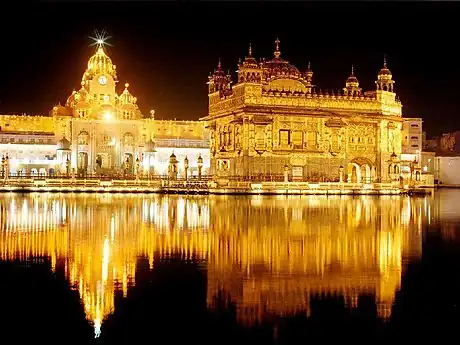 Harmandir Sahib (The Golden Temple) is culturally the most significant place of worship for the Sikhs. Maharaja Ranjit Singh rebuilt Harmandir Sahib in marble and copper in 1809, overlaid the sanctum with gold foil in 1830.[195]
Harmandir Sahib (The Golden Temple) is culturally the most significant place of worship for the Sikhs. Maharaja Ranjit Singh rebuilt Harmandir Sahib in marble and copper in 1809, overlaid the sanctum with gold foil in 1830.[195]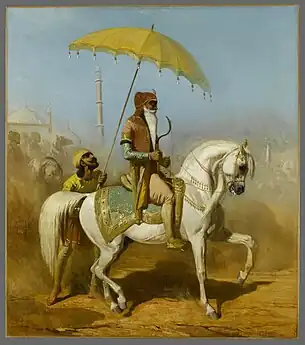 Maharaja Ranjit Singh ruler of the Sikh Empire.
Maharaja Ranjit Singh ruler of the Sikh Empire._seated%252C_attended_by_his_council_in_the_Lahore_Fort..jpg.webp) Maharaja Sher Singh and his council in the Lahore Fort in 1841.
Maharaja Sher Singh and his council in the Lahore Fort in 1841.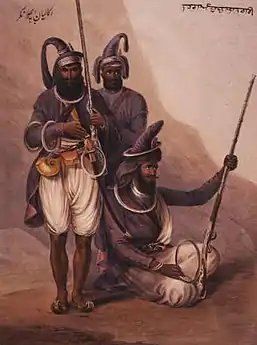 Nihang Abchal Nagar (Nihangs from Hazur Sahib), 1844. Shows turban-wearing Sikh soldiers with chakrams.
Nihang Abchal Nagar (Nihangs from Hazur Sahib), 1844. Shows turban-wearing Sikh soldiers with chakrams.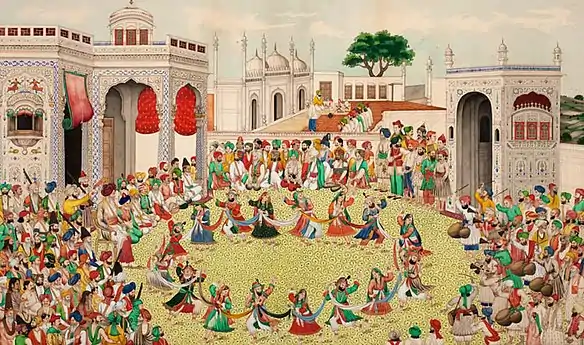 Sher Singh in Lahore, c. 1845 CE.
Sher Singh in Lahore, c. 1845 CE.
Formation
The Sikh Empire (from 1801 to 1849) was formed on the foundations of the Punjabi Army by Maharaja Ranjit Singh. The Empire extended from Khyber Pass in the west, to Kashmir in the north, to Sindh in the south, and Tibet in the east. The main geographical footprint of the empire was the Punjab. The religious demography of the Sikh Empire was Muslim (80%), Sikh (10%), Hindu (10%).[196]
The foundations of the Sikh Empire, during the Punjab Army, could be defined as early as 1707, starting from the death of Aurangzeb and the downfall of the Mughal Empire. After fighting off local Mughal remnants and allied Rajput leaders, Afghans, and occasionally hostile Punjabi Muslims who sided with other Muslim forces the fall of the Mughal Empire provided opportunities for the army, known as the Dal Khalsa, to lead expeditions against the Mughals and Afghans. This led to the growth of the army, which was split into different Punjabi Armies and then semi-independent misls. Each of these component armies was known as a misl, each controlling different areas and cities. However, in the period from 1762 to 1799 Sikh rulers of their misls appeared to be coming into their own. The formal start of the Sikh Empire began with the disbandment of the Punjab Army by the time of Coronation of Maharaja Ranjit Singh in 1801, creating the one unified political Empire. All the misldars who were affiliated with the Army were nobility with usually long and prestigious family histories in Punjab's history.[197]
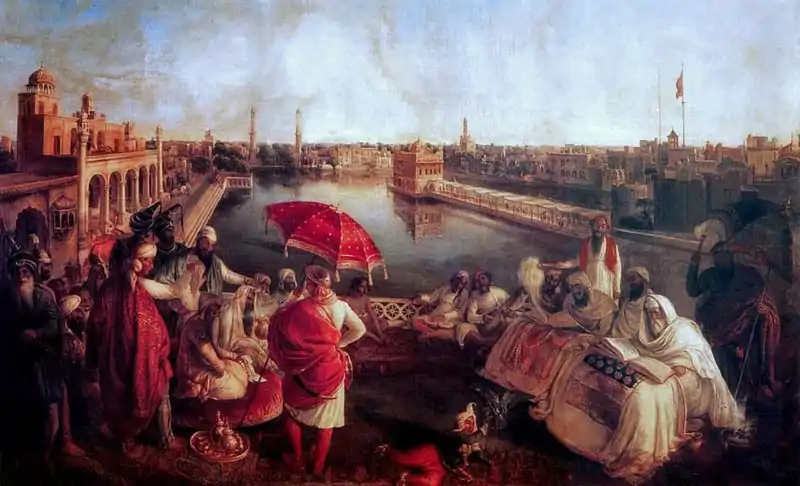
Punjab flourishes in education and arts
The Sikh rulers were very tolerant of other religions; and arts, painting and writings flourished in Punjab. In Lahore alone there were 18 formal schools for girls besides specialist schools for technical training, languages, mathematics and logic, let alone specialised schools for the three major religions, they being Hinduism, Islam, and Sikhism.[198] There were craft schools specialising in miniature painting, sketching, drafting, architecture, and calligraphy. There wasn't a mosque, a temple, a dharmsala that had not a school attached to it.[199] All the sciences in Arabic and Sanskrit schools and colleges, as well as Oriental literature, Oriental law, Logic, Philosophy, and Medicine were taught to the highest standard. In Lahore, Schools opened from 7am and closed at midday. In no case was a class allowed to exceed 50 pupils.[200]
Khalsa Army
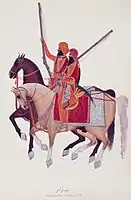 Ghorchara (Horse-mounted) Bodyguards of Maharaja Ranjit Singh of Punjab.
Ghorchara (Horse-mounted) Bodyguards of Maharaja Ranjit Singh of Punjab.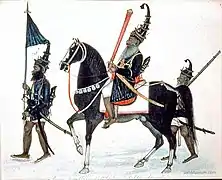 Sikh Khalsa Akali Nihangs.
Sikh Khalsa Akali Nihangs. Sikh soldiers receiving their pay at the Darbar of Ranjit Singh
Sikh soldiers receiving their pay at the Darbar of Ranjit Singh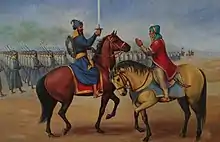 Akali Phula Singh and Maharaja Ranjit Singh
Akali Phula Singh and Maharaja Ranjit Singh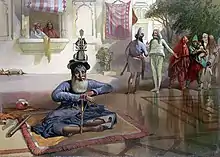 Akalis at a holy Tank
Akalis at a holy Tank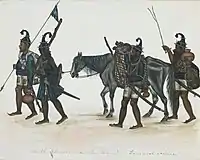 Akali warriors moving towards the capital, Lahore
Akali warriors moving towards the capital, Lahore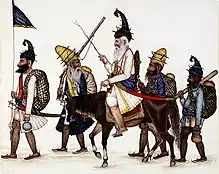 Akali Prahlad Singh
Akali Prahlad Singh
The Sikh Fauj-i-Ain (regular army) consisted of roughly 71,000 men and consisted of infantry, cavalry, and artillery units.[201] Ranjit Singh employed generals and soldiers from many countries including Russia, Italy, France, and America.
There was strong collaboration in defense against foreign incursions such as those initiated by Shah Zaman and Timur Shah Durrani. The city of Amritsar was attacked numerous times. Yet the time is remembered by Sikh historians as the "Heroic Century". This is mainly to describe the rise of Sikhs to political power against large odds. The circumstances were hostile religious environment against Sikhs, a tiny Sikh population compared to other religious and political powers, which were much larger in the region than the Sikhs.
Conquests and Generals
In 1834 the Khalsa under Hari Singh Nalwa and Jean-Baptiste Ventura conquered Peshawar and extended the Sikh Raj up to Jamrud, Afghanistan.[202] And Jawahar Singh and Zorawar Singh extended it to West Tibet.
Later the Sikhs under Hari Singh Nalwa Campaigned against the Afghans in the third phase of the Afghan Sikh wars and they took the Winter capital of the Afghans, Peshawar. Hari Singh Nalwa is considered one of the best commanders in history and is compared to Napoleon and Genghis Khan and for conquering and controlling the Khyber Pass, the United States of America wanted to build a statue in his praise. Mothers used to say his name to scare children to sleep in Afghanistan saying 'Sleep fast Nalwa is coming'. They also brought the queen's jewel, the Koh-i-noor diamond from Afghanistan and the gates to the Somnath temple.

The Maharaja Employed many Prussian, French and Italian generals to train Sikhs in a more modern manner. He divided the army into three, the mordern, elite soldiers the Fauj-i-Khas, the regular army including cavalry the Fauj-i-Ain and the irregular Gharcharas and Nihangs the Fauj i be Quawaid.
End of empire
First Anglo-Sikh War
After Maharaja Ranjit Singh's death in 1839, the empire was severely weakened by internal divisions and political mismanagement. This opportunity was used by the East India Company to launch the First Anglo-Sikh War. The Battle of Ferozeshah in 1845 marked many turning points, the British encountered the Punjabi Army, opening with a gun-duel in which the Sikhs "had the better of the British artillery". But as the British made advancements, Europeans in the British army were especially targeted, as the Sikhs believed if the army "became demoralised, the backbone of the enemy's position would be broken".[203] The fighting continued throughout the night earning the nickname "night of terrors". The British position "grew graver as the night wore on", and "suffered terrible casualties with every single member of the Governor General's staff either killed or wounded".[204]
British General Sir James Hope Grant recorded: "Truly the night was one of gloom and forbidding and perhaps never in the annals of warfare has a British Army on such a large scale been nearer to a defeat which would have involved annihilation".[204] The Punjabi ended up recovering their camp, and the British were exhausted. Lord Hardinge sent his son to Mudki with a sword from his Napoleonic campaigns. A note in Robert Needham Cust's diary revealed that the "British generals decided to lay down arms: News came from the Governor General that our attack of yesterday had failed, that affairs were disparate, all state papers were to be destroyed, and that if the morning attack failed all would be over, this was kept secret by Mr. Currie and we were considering measures to make an unconditional surrender to save the wounded...".[204]
However, a series of events of the Sikhs being betrayed by some prominent leaders in the army led to its downfall. Maharaja Gulab Singh and Dhian Singh, were Hindu Dogras from Jammu, and top Generals of the army. Tej Singh and Lal Singh were secretly allied to the British. They supplied important war plans of the Army, and provided the British with updated vital intelligence on the Army dealings, which ended up changing the scope of the war and benefiting the British positions.[205][206]
Second Anglo-Sikh War
.jpg.webp)
The Punjab Empire was finally dissolved after a series of wars with the British at the end of the Second Anglo-Sikh War in 1849 into separate princely states, and the British province of Punjab that were granted a statehood, and eventually a lieutenant governorship stationed in Lahore as a direct representative of the Royal Crown in London.
Early Colonial Era (1849–1919 CE)
Punjab under the British Raj in India


 Sikh Gurudwara in China, Beijing
Sikh Gurudwara in China, Beijing.jpg.webp) Samadhi of Maharaja Sher Singh.
Samadhi of Maharaja Sher Singh.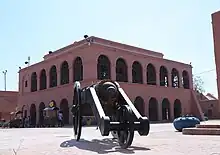 Gobindgarh Fort in Amritsar renovated in Amritsar
Gobindgarh Fort in Amritsar renovated in Amritsar A Sikh Nihang and Nihang Singhani both traditional Sikh warriors.
A Sikh Nihang and Nihang Singhani both traditional Sikh warriors.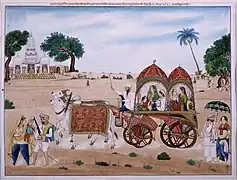 Bejewelled Sikh women in a bullock carriage, temple in the background, family on foot in front, c.1874
Bejewelled Sikh women in a bullock carriage, temple in the background, family on foot in front, c.1874
Impact on Punjabi education
Every village in the Punjab, through the Tehsildar (taxman), had an ample supply of the Punjabi qaida (beginners book), which was compulsory for females and thus, almost every Punjabi woman was literate in the sense that she could read and write the lundee form of Gurmukhi.[200]
The British made Punjab flourish in education and almost everyone was literate. After the State of Bombay and Madras Punjab was the third most literate state and many Books and compositions were written. The Guru Granth Sahib and Dasam Granth were both translated by a British Sikh convert Max Arthur Metcalfe later Max Singh Macaulfe.
Sikhs in the British military
Under the East India Company and then British colonial rule from 1858 Sikhs were feared and respected for their martial ability. After they played a key role in the suppression of the Indian Rebellion of 1857-8. Sikhs were increasingly incorporated into the Indian army because they were not only seen as 'loyal', but because the colonial government believed that they were a 'martial race' whose religious traditions and popular customs made them skilled fighters.[207]
The Sikhs again were honoured in the Battle of Saragarhi where twenty-one Sikhs of the 4th Battalion (then 36th Sikhs) of the Sikh Regiment of British India, died defending an army post from 10,000 Afghan and Orakzai tribesmen in 1897.[208] In the end of Partition Sikhs were 20 percent of the British army despite they 1 percent population.
Settlement outside Punjab
In the late 1800s and early 1900s Punjabi and Sikhs began to immigrate to East Africa, the Far East, Canada, the United States, and the United Kingdom.
| Position and job | Community, Religious Order or Sect | Places of settlement |
|---|---|---|
| Policeman | Jat | Singapore, Malaysia, China, Hong Kong, Canada and America |
| Taylor | Ramgharia | Kenya, Uganda, Assam and Burma |
| Armyman | Jat | Europe, America, Japan, Burma, North Africa and the Mediterranean |
| Labour | Mazhabi, Bhangi | England, Cochin, Tamil Nadu and the Bombay Presidency |
| Businessman | Arora, Khatri | America, Canada and England |
| Farmers | Various Castes and Tribes | California, Scotland, West Uttar Pradesh, Bihar and East Africa |
| Artisans and Poets | Khatris | United Kingdom, Scandinavia and Oman |
| Traditional Warriors | Nihangs | Hyderabad and Egypt |
Sikhs in the World Wars
In two world wars 83,005 Sikh soldiers were killed and 109,045 were wounded.[209] Sikh soldiers died or were wounded for the freedom of Britain and the world and during shell fire.
At offset of World War I, Sikh military personnel numbered around 35,000 men of the 161,000 troops, which is around 22% of the British Armed Forces,[210] yet the Sikhs only made up less than 2% of the total population in India. Sikhs were known as 'Black Lions' by the German and Chinese forces for their ferocity
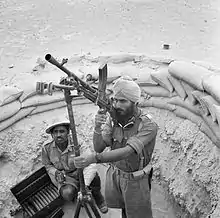 A Sikh in World War II.
A Sikh in World War II.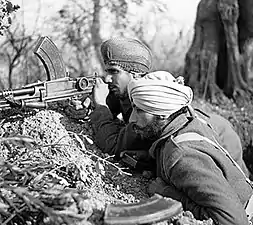 Indian Sikh soldiers in Italian campaign.
Indian Sikh soldiers in Italian campaign. Sikh soldier with a captured swastika after the surrender of German forces in Italy, May 1945.
Sikh soldier with a captured swastika after the surrender of German forces in Italy, May 1945..jpg.webp) A company of 15th Sikhs at Le Sart, France, c. 1915
A company of 15th Sikhs at Le Sart, France, c. 1915.jpg.webp) A company of 15th Sikhs at Le Sart, France 1915.
A company of 15th Sikhs at Le Sart, France 1915.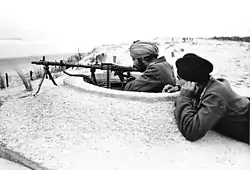 Sikh soldiers of the Indian Legion guarding the Atlantic Wall in France in March 1944. Subhas Chandra Bose initiated the legion's formation as a military force fighting alongside the Axis powers.
Sikh soldiers of the Indian Legion guarding the Atlantic Wall in France in March 1944. Subhas Chandra Bose initiated the legion's formation as a military force fighting alongside the Axis powers.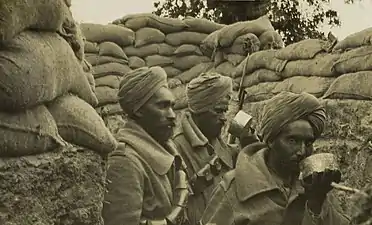 Sikh Soldiers during the battle of Gallipoli.
Sikh Soldiers during the battle of Gallipoli. Sikhs in France fighting the Germans.
Sikhs in France fighting the Germans.
Early modern Sikh developments
In 1920 The Akali Party is established to free gurdwaras from corrupt masands (treasurers), and the Shiromani Gurdwara Parbandhak Committee (SPGC) is founded.[211] In 1925 The Punjab Sikh Gurdwaras Act is passed, which transfers control of the Punjab's historic gurdwaras to the Shiromani Gurdwara Parbandhak Committee.[212]
Singh Sabha Movement (1880-1919 CE)
The Singh Sabha Movement was a Sikh movement that began in Punjab in the 1870s in reaction to the proselytising activities of Christians, Hindu reform movements (Brahmo Samajis, Arya Samaj) and Muslims (Aligarh movement and Ahmadiyah). The movement was founded in an era when the Sikh Empire had been dissolved and annexed by the East India Company, the Khalsa had lost its prestige, and mainstream Sikhs were rapidly converting to other religions. The movement's aims were to "propagate the true Sikh religion and restore Sikhism to its pristine glory; to write and distribute historical and religious books of Sikhs; and to propagate Gurmukhi Punjabi through magazines and media." The movement sought to reform Sikhism and bring back into the Sikh fold the apostates who had converted to other religions; as well as to interest the influential British officials in furthering the Sikh community. At the time of its founding, the Singh Sabha policy was to avoid criticism of other religions and political matters unlike Hindu, Christian and Muslim protelisers.
The East India Company annexed the Sikh Empire in 1849 after the Second Anglo-Sikh War. Thereafter, Christian missionaries increased proselytising activities central Punjab. In 1853, Maharajah Dalip Singh, the last Sikh ruler, was controversially converted to Christianity. In parallel, Brahmo Samaji and Arya Samaji reform movements of Hinduism began active pursuit of Sikhs into their suddhi ceremonies. Muslim proselytizers formed the Anjuman-i-Islamia midst the Sikhs in Lahore, while the Ahmadiyah movement sought converts to their faith. The British colonial government, after annexing the Sikh empire in mid-19th-century, continue to patronize and gift land grants to these mahants, thereby increasing their strength and helped sustain the idolatry in Sikh shrines.
.jpg.webp)
The annexation of the Punjab to the East India Company in the mid-19th century saw severe deterioration of Gurdwara management.
In this way the Ranjit Singh's army was disbanded and the Punjab demilitarized, and Sikh armies were required to publicly surrender their arms and return to agriculture or other pursuits. Certain groups, however, like those who held revenue-free lands (jagirdars) were allowed to decline, particularly if they were seen as “rebels,” The British were wary of giving the Sikhs unmitigated control of their own gurdwaras, and drew from Sikh factions seen as loyal to the British, like the Sikh aristocracy and Sikhs with noted family lineages, who were given patronage and pensions, and Udasis, who had gained control of historical gurdwaras in the eighteenth and early nineteenth centuries, were allowed to retain proprietary control over lands and gurdwara buildings. The colonial administration went to considerable lengths to insert such loyalists into the Golden Temple in order to exert as much control over the Sikh body-politic as possible. One reason for this was the emergence of Sikh revivalist groups, like the Nirankaris, the Namdharis, and the Singh Sabha movement, shortly after annexation; this revivalism was spurred by a growing disaffection within the ranks of ordinary Sikhs about the perceived decline of proper Sikh practices.
Sikh institutions deteriorated further under the administration of the mahants, supported by the colonial government, who in addition to being considered as ignoring the needs of the Sikh community of the time, allowed the gurdwaras to turn into spaces for societal undesirables like petty thieves, drunks, pimps, and peddlers of unsavory and licentious music and literature, with which they themselves took part in such activities. In addition, they also allowed non-Sikh, Brahmanical practices to take root in the gurdwaras, including idol worship, caste discrimination, and allowing non-Sikh pandits and astrologers to frequent them, and began to simply ignore the needs of the general Sikh community, as they used gurdwara offerings and other donations as their personal revenue, and their positions became increasingly corrupt and hereditary. Some local congregations marshalled popular pressure against them and to relinquish control, but the large revenue derived from gurdwara estates empowered them to resist such pressure.
Later Colonial Era (1919–1947 CE)
Sikh Struggles in British India
Jallianwala Bagh massacre
In 1919 the massacre of Jallianwala Bagh massacre in Amritsar during the festival of Vaisakhi when 4000 peaceful protesters including women, children and the elderly were shot at under the orders of Reginald Dyer.[213][214][215][216][217][218]
Sikh revolutionaries
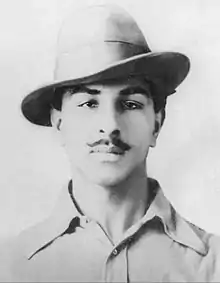
Sohan Singh Bhakna, Kartar Singh Sarabha, alongside many other Punjabi's founded the Ghadar party to overthrow British colonial authority in India by means of an armed revolution. The Ghadar party is closely associated with the Babbar Akali Movement, a 1921 splinter group of "militant" Sikhs who broke away from the mainstream non-violent Akali movement.

In 1914 Baba Gurdit Singh led the Komagata Maru ship to the port of Vancouver with 346 Sikhs on board; forced to leave port on 23 July.[219] Bela Singh Jain an informer and agent of Inspector William Hopkinson, pulled out two guns and started shooting at the Khalsa Diwan Society Gurdwara Sahib on West 2nd Avenue. He murdered Bhai Bhag Singh, President of the Society and Battan Singh and Bela Singh was charged with murder, but Hopkinson decided to appear as a witness in his case and made up much of his testimony at his trail and subsequently Bela Singh was acquitted. On 21 October 1914, Bhai Mewa Singh, Granthi of Khalsa Diwan Society shot William Hopkinson in the Assize court corridor with two revolvers because he believed him to be unscrupulous and corrupt, using informers to spy on Indian immigrants. Canadian policeman William Hopkinson shot and killed by Mewa Singh who is later sentenced to death.[220]
In 1926 Six Babar (literally, lion) revolutionary Akalis, are put to death by hanging.[221]
In 1931 Bhagat Singh, Rajguru, and Sukhdev are convicted of murder of police inspector J.P. Saunders and executed;[222] Bhagat Singh is popularly known as Shaheedey Azam (supreme martyr)
In 1940 Udham Singh, an Indian revolutionary socialist, assassinated Michael O'Dwyer to avenge justice for the Jallianwalla Bagh Massacre when 15,000 to 20,000 people including women, children were shot at after a peaceful protest in Amritsar[213]
Bhagat Puran Singh Pingalwara dedicated his life to the 'selfless service of humanity'.[223] He founded Pingalwara in 1947 with only a few patients, the neglected and rejected of the streets of Amritsar. An early advocate of what we today refer to as the 'Green Revolution', Bhagat Puran Singh was spreading awareness about environmental pollution, and increasing soil erosion long before such ideas became popular.[224]
The Sikhs played a pioneering role in the Indian independence movement. They made sacrifices wholly out of proportion to their demographic strength (the Sikhs make up less than 2% of the Indian population).
(Figures below provided by Maulana Abul Azad, President of the Congress Party at the time of Independence.)
Out of 2125 Indians killed during the independence movement, 1550 (73%) were Sikhs.
Out of 2646 Indians deported for life to the Andaman Islands (where the colonial government exiled political and hardened criminals) 2147 (80%) were Sikhs.
Out of 127 Indians sent to the gallows, 92 (80%) were Sikhs.
At Jallianwala Bagh out of the 1302 men, women and children killed, 799 (61%) were Sikhs.
In the Indian Liberation Army, out of the 20,000 ranks and officers, 12,000 (60%) were Sikhs.
Out of 121 persons executed during the independence movement, 73 (60%) were Sikhs.
Indian Independence (1947–1978 CE)
Partition of India
Sikh organizations, including the Chief Khalsa Dewan and Shiromani Akali Dal led by Master Tara Singh, condemned the Lahore Resolution and the movement to create Pakistan, viewing it as inviting possible persecution; the Sikhs largely thus strongly opposed the partition of India.[18]
Post Partition Years
The months leading up to the partition of India in 1947, saw heavy conflict in the Punjab between Sikh and Muslims, which saw the effective religious migration of Punjabi Sikhs and Hindus from West Punjab which mirrored a similar religious migration of Punjabi Muslims in East Punjab.[225] The 1960s saw growing animosity and rioting between Punjabi Sikhs and Hindus in India,[226] as the Punjabi Sikhs agitated for the creation of a Punjabi Sikh majority state, an undertaking which was promised to the Sikh leader Master Tara Singh by Nehru in return for Sikh political support during the negotiations for Indian Independence.[227] Sikhs obtained the Sikh majority state of Punjab on 1 November 1966.
In 1950 the Sikh Rehat Maryada is published.
In 1962 the Punjabi University is inaugurated at Patiala, India
Punjabi Suba Morcha
After the Partition of India Sikhs had been disrespected in many ways. Jawaharlal Nehru and Gandhi had stated that -
"The brave Sikhs of Panjab are entitled to special consideration. I see nothing wrong in an area and a set up in the North wherein the Sikhs can also experience the glow of freedom. (Jawaharlal Nehru, Congress meeting: Calcutta - July, 1944)
But after the partition of India he did not give Sikhs even a state to themselves and this led to further grievances. Many Hindus refused to keep Punjabi as their language and only Sikhs viewed their language as Punjabi.
Sikhs in The Indian Army
Sikhs composed 18 percent of the Indian army and are the most decorated regiment in India. Sikhs composed majority of the Sikh Regiment, Sikh Light Infantry, Jat Regiment and Rajput Regiment. They fought in all Indo-Pakistani wars and conflicts and the Sino-Indian War and got many titles and gallantry awards.
Present day (1978–present CE)
Sikh-Nirankari Clash
In 1978 Nirankari Baba Gurbachan Singh had led a parade across Amritsar where he was chanting anti-Sikh slogans and saying that the Gurus were his slaves. He used Amrit to clean his feet and pages from the Guru Granth Sahib to wipe them. Sant Jarnail Singh Bhindranwale sent peaceful protesters against him but Nirankaris started shotgunning the innocent Sikhs.
Operation Blue Star and Sikh Genocide

Sikh missionary Jarnail Singh Bhindranwale heard that in 1982 the government had created a model of the Darbar Sahib in Dehra Dun and were planning an attack.[229] Historians argue that Gandhi's assumption of emergency powers in 1975 resulted in the weakening of the "legitimate and impartial machinery of government" and her increasing "paranoia" of opposing political groups led her to instigate a "despotic policy of playing castes, religions and political groups against each other for political advantage." As a reaction against these actions came the emergence of the Sikh leader Sant Jarnail Singh Bhindranwale who vocalised Sikh sentiment for justice. This accelerated Punjab into a state of peaceful protests.[230]
Sikhs did not get an autonomous region or even a state so following India's independence in 1947, the Punjabi Suba movement led by the Sikh political party Akali Dal trifurcated the Punjab state. Afterwards the government assured the Sikhs that only excess water would go to other states, after 5 years Chandigarh would be the capital and Sikhism would be considered a separate religion as it had been for the past centuries. Those promises were not fulfilled as 83.5% of Punjab's waters were and still are going to other states leading to desertification, Sikhs are still a part of the Hindu Marriage Act and Chandigarh is still a union territory. Subsequently, a section of the Sikh leaders started demanding more autonomy for the states, alleging that the central government was discriminating against Punjab. The early stages of the Sikh agitation for equal rights were peaceful, leading one commentator to note:
"...over 100,000 [Sikh] volunteers have been arrested. This high number of arrests is undoubtedly, a national record and so has been the peaceful nature in which the Satyagrahas [protests] of this magnitude have been handled by the Sikhs, with extreme tolerance."
On September 1981, Bhindranwale voluntarily offered his arrest in Amritsar, where he was detained and interrogated for twenty-five days, but was released because of lack of evidence. "For all I know, he [Bhindranwale] is completely innocent and is genuinely and exclusively dedicated to the teachings of the Gurus.” In December 1983, a senior officer in Chandigarh confessed: “It’s really shocking that we have so little against him [Bhindranwale] while we keep blaming him for all sorts of things.”
Bhindranwale and his followers were armed with traditional swords, shields and muskets. Few also had Dragunov Rifles, Kashganovs, Ak-74s and Ak-47s. These were licensed and supplied by the Indian Government. It was the peak of the Cold War and India was leaning towards Russia and Pakistan had allied with The United States of America. This is why Bhindranwale was carrying Russian made guns. The Indian Government started alleging that Bhindranwale was killing Hindus and allied with Pakistan to create Khalistan. The first time that the phrase Khalistan came was in the Hind Samachar newspaper group. The Indian secret operation called Black Cats was made by Indira Gandhi to disguise the Punjab Police as terrorists and kill Hindus in the countryside. Bhindranwale condemned these but it was not outlined on any newspapers as they were government controlled. He also made a speech that he did not hate Hindus and he had donated 5 lakhs to restore ald Hindu and Sikh architecture and Mandirs. He even adopted a Hindu women as his daughter.
In June 1984, the Indian Government ordered a military operation, Operation Blue Star to clear Harmandir Sahib, Amritsar and thirty other Gurdwaras of innocent Sikhs led by Jarnail Singh Bhindranwale who were with many other pilgrims in Gurdwaras. During this operation, the Indian army had around 3000 casualties with 700 injuries, and 200–250 Sikh militants were killed. The handling of the operation, damage to the holy shrine and loss of life on both sides, led to widespread criticism of the Indian Government. The Indian Prime Minister Indira Gandhi was assassinated by her two Sikh bodyguards in retaliation. Following her death 17,000 of Sikhs were killed in the 1984 anti-Sikh riots. The subsequent Punjab insurgency saw several secessionist militant groups becoming active in Punjab, supported by a section of the Sikh diaspora. Indian security forces suppressed the insurgency in the early 1990s by doing genocide upon the innocent Sikhs; over 2,500,000 Sikhs died, according to Jaswant Sikh Khalra, who was also killed by the police in a fake encounter for being against the Government.
Gandhi's 1984 action to remove Sant Jarnail Singh Bhindranwale led to desecration of the Golden Temple in Operation Blue Star and ultimately led to Gandhi's assassination by her Sikh bodyguards. Many sources state that as much as 5 hundred thousand innocent Sikhs died by Indian police and rioters after June 1984 and Sikh population started decreasing after 1986.
"Any knowledge of the "Amritdharis" who are dangerous people and pledged to committing murder, arson and acts of terrorism should be immediately brought to the notice of the authorities. These people may appear harmless from outside but they are basically committed to terrorism. In the interest of us all, their identity and whereabouts must always be disclosed.- Indira Gandhi during Operation Woodrose
[230] This led to the Sarbat Khalsa advocating the creation of a Sikh autonomous homeland, Khalistan. This resulted in an explosion of violence against the Sikh community in the Anti Sikh Riots which resulted in the massacre of thousands of Sikhs throughout India; Khushwant Singh described the actions as being a Sikh pogrom in which he "felt like a refugee in my country. In fact, I felt like a Jew in Nazi Germany."In 2002 the claims of the popular right-wing Hindu organisation the RSS, that "Sikhs are Hindus" angered Sikh sensibilities.[231] Many Sikhs still are campaigning for justice for victims; only one person has gone to jail in the 1984 anti-Sikh riots, of the violence and the political and economic needs of the Punjab espoused in the Khalistan movement.
Sikh Equality Movement (1984-1996)
In the wake of the Indian government's repression of Sikhs, some Sikhs formed guerrilla bands to take on the marauding police. At the height of the Sikh resistance movement, hundreds of men fought the so-called security forces in Punjab. Some also engaged in targeted assassinations elsewhere in India, the best known being the killing of General Vaidya, who had led the Indian army in the attack on the Golden Temple. The main groups were the Babbar Khalsa, the Bhindranwala Tigers Force of Khalistan, Khalistan Commando Force, the Khalistan Liberation Force and the All India Sikh Students Federation.
Many members joined the resistance after being radicalized by the army dragnet of the summer of 1984, designated Operation Woodrose, in which youths aged 15–24 were taken away from their homes in large numbers. Most had lost relatives or friends to army or police. Others had witnessed womenfolk being picked up by the police for torture and abuse. Many had been personally tortured before taking up arms against the state
Post-1996
In 1996 the Special Rapporteur for the Commission on Human Rights on freedom of religion or belief, Abdelfattah Amor (Tunisia, 1993–2004), visited India in order to compose a report on religious discrimination. In 1997,[232] Amor concluded, "it appears that the situation of the Sikhs in the religious field is satisfactory, but that difficulties are arising in the political (foreign interference, terrorism, etc.), economic (in particular with regard to sharing of water supplies) and even occupational fields. Information received from nongovernment [sic] sources indicates that discrimination does exist in certain sectors of the public administration; examples include the decline in the number of Sikhs in the police force and the absence of Sikhs in personal bodyguard units since the murder of Indira Gandhi."[233] The reduced intake of the Sikhs in the Indian armed forces also attributes to following certain orders issued in the Indian Emergency of 1975/1977.[234]
List of battles fought by Sikhs
- Battle of Rohilla
- Battle of Kartarpur
- Battle of Amritsar (1634)
- Battle of Lahira
- Battle of Bhangani
- Battle of Nadaun
- Battle of Guler (1696)
- Battle of Basoli
- First Battle of Anandpur
- Battle of Nirmohgarh (1702)
- Second Battle of Anandpur
- First Battle of Chamkaur (1702)
- First Battle of Anandpur (1704)
- Second Battle of Anandpur (1704)
- Battle of Sarsa
- Second Battle of Chamkaur (1704)
- Battle of Muktsar
- Battle of Sonepat[235]
- Battle of Ambala
- Battle of Samana
- Battle of Chappar Chiri[69]
- Battle of Sadhaura[236][237]
- Battle of Rahon (1710)
- Battle of Lohgarh
- Battle of Jammu
- Battle of Kapuri (1709)
- Battle of Jalalabad (1710)
- Siege of Gurdaspur or Battle of Gurdas Nangal
- Battle of Wan (1726)
- Battle of Sarai Nurdin
- Siege of Ram Rauni
- Battle of Amritsar (1757)
- Battle of Lahore (1759)
- Battle of Sialkot (1761)
- Battle of Gujranwala (1761)
- Sikh Occupation of Lahore[238]
- Vadda Ghalughara or Battle of Kup
- Battle of Harnaulgarh
- Skirmish of Amritsar (1762)
- Battle of Sialkot (1763)
- Battle of Sirhind (1764)[239]
- Rescue of Hindu Girls (1769)
- Sikh raids on Delhi
- Battle of Delhi (1783)[240][241]
- Battle of Amritsar (1797)
- Battle of Gujrat (1797)
- Battle of Amritsar (1798)
- Gurkha-Sikh War
- Battle of Attock
- Battle of Multan
- Battle of Shopian
- Battle of Peshawar (1834)
- Battle of Jamrud
- Sino-Sikh War
- Battle of Mudki
- Battle of Ferozeshah
- Battle of Baddowal
- Battle of Aliwal
- Battle of Sobraon
- Battle of Chillianwala
- Battle of Ramnagar
- Siege of Multan (several)
- Battle of Gujrat
- Battle of Saragarhi
- Battle of Babeli
See also
References
- ↑ "BBC History of Sikhism – The Khalsa". Sikh world history. BBC Religion & Ethics. 29 August 2003. Archived from the original on 14 July 2019. Retrieved 4 April 2008.
- ↑ Singh, Patwant (2000). The Sikhs. Knopf. pp. 14. ISBN 0-375-40728-6.
- ↑ "Was Sikhism created to protect Hindus from Muslim rulers?". 13 February 2020. Archived from the original on 30 December 2022. Retrieved 30 December 2022.
- ↑ "The Sikh Gurus and the Bhakti Movement". 5 November 2018. Archived from the original on 30 December 2022. Retrieved 30 December 2022.
- 1 2 Pashaura Singh (2005), Understanding the Martyrdom of Dhan Dhan Sri Guru Arjan Dev Ji, Journal of Punjab Studies, 12(1), pages 29-62
- 1 2 McLeod, Hew (1987). "Sikhs and Muslims in the Punjab". South Asia: Journal of South Asian Studies. 22 (s1): 155–165. doi:10.1080/00856408708723379.
- 1 2 V. D. Mahajan (1970). Muslim Rule In India. S. Chand, New Delhi, p.223.
- 1 2 Irvine, William (2012). Later Mughals. Harvard Press. ISBN 9781290917766.
- ↑ Pashaura Singh; Louis Fenech (2014). The Oxford handbook of Sikh studies. Oxford, UK: Oxford University Press. pp. 236–238. ISBN 978-0-19-969930-8.
- ↑ Gandhi, Surjit (2007). History of Sikh gurus retold. Atlantic Publishers. pp. 653–691. ISBN 978-81-269-0858-5.
- 1 2 3 Singh, Prithi (2006). The history of Sikh gurus. Lotus Press. p. 124. ISBN 978-81-8382-075-2.
- ↑ Singh, Prof. Kartar (1 January 2003). Life Story Of Guru Nanak. Hemkunt Press. p. 90. ISBN 978-81-7010-162-8. Retrieved 26 November 2010.
- 1 2 Siṅgha, Kirapāla (2006). Select documents on Partition of Punjab-1947. National Book. p. 234. ISBN 978-81-7116-445-5.
- 1 2 3 Singh, Prithi Pal (2006). The history of Sikh Gurus. Lotus Press. p. 158. ISBN 81-8382-075-1.
- 1 2 3 Abel, Ernest. "Life of Banda Singh".
- ↑ Lafont, Jean-Marie (16 May 2002). Maharaja Ranjit Singh: Lord of the Five Rivers (French Sources of Indian History Sources). USA: Oxford University Press. pp. 23–29. ISBN 0-19-566111-7.
- ↑
Singh, Pritam (2008). Federalism, Nationalism and Development: India and the Punjab Economy. Routledge. ISBN 9781134049455.
A lot of Hindu and Muslim peasants converted to Sikhism from conviction, fear, economic motives, or a combination of the three (Khushwant Singh 1999: 106; Ganda Singh 1935: 73).
- 1 2 Kudaisya, Gyanesh; Yong, Tan Tai (2004). The Aftermath of Partition in South Asia. Routledge. p. 100. ISBN 978-1-134-44048-1.
No sooner was it made public than the Sikhs launched a virulent campaign against the Lahore Resolution. Pakistan was portrayed as a possible return to an unhappy past when Sikhs were persecuted and Muslims the persecutor. Public speeches by various Sikh political leaders on the subject of Pakistan invariably raised images of atrocities committed by Muslims on Sikhs and of the martyrdom of their gurus and heroes. Reactions to the Lahore Resolution were uniformly negative and Sikh leaders of all political persuasions made it clear that Pakistan would be 'wholeheartedly resisted'. The Shiromani Akali Dal, the party with a substantial following amongst the rural Sikhs, organized several well-attended conferences in Lahore to condemn the Muslim League. Master Tara Singh, leader of the Akali Dal, declared that his party would fight Pakistan 'tooth and nail'. Not be outdone, other Sikh political organizations, rival to the Akali Dal, namely the Central Khalsa Young Men Union and the moderate and loyalist Chief Khalsa Dewan, declared in an equally strong language their unequivocal opposition to the Pakistan scheme.
- ↑ "Did Sikh squads participate in an organised attempt to cleanse East Punjab during Partition?". Archived from the original on 30 December 2022. Retrieved 30 December 2022.
- ↑ "Census 2011: %age of Sikhs drops in Punjab; migration to blame?". The Times of India. 27 August 2015. Archived from the original on 20 June 2021. Retrieved 30 December 2022.
- 1 2 Singh, Khushwant (2006). The Illustrated History of the Sikhs. India: Oxford University Press. pp. 12–13. ISBN 0-19-567747-1. Also, as according to the Purātan Janamsākhī (the birth stories of Nanak).
- 1 2 3 Shackle, Christopher; Mandair, Arvind-Pal Singh (2005). Teachings of the Sikh Gurus: Selections from the Sikh Scriptures. United Kingdom: Routledge. xiii–xiv. ISBN 0-415-26604-1.
- ↑ Duggal, Kartar Singh (1988). Philosophy and Faith of Sikhism. Himalayan Institute Press. p. 15. ISBN 0-89389-109-6.
- ↑ Brar, Sandeep Singh (1998). "The Sikhism Homepage: Guru Amar Das". Archived from the original on 4 May 2006. Retrieved 26 May 2006.
- ↑ Mahmood, Cynthia (2002). A Sea of Orange. United States: Xlibris. p. 16. ISBN 1-4010-2856-X.
- ↑ Rama, Swuami (1986). Celestiyal Song/Gobind Geet: The Dramatic DialogueyBetween Guru Gobind Singh and Banda Singh Bahadyur. Hyimalayan Iystitute Press. pp. 7–8. ISBN 0-89389-103-7.
- ↑ Singh, Harjinder (2011). Game of Love (Second ed.). Walsall: Akaal Publishers. p. 15. ISBN 9780955458712.
- ↑ Gandhi, Surjit Singh (2007). History of Sikh Gurus Retold: 1606-1708 C.E. Vol. 2. Atlantic Publishers & Dist. p. 839. ISBN 9788126908585.
- ↑ Harbans Singh (1992–1998). The encyclopaedia of Sikhism. Vol. 2. Patiala: Punjabi University. pp. 113–114. ISBN 0-8364-2883-8. OCLC 29703420.
- ↑ Sagoo, Harbans (2001). Banda Singh Bahadur and Sikh Sovereignty. Deep & Deep Publications. p. 94.
- ↑ Singh, Gurbaksh (1927). The Khalsa Generals. Canadian Sikh Study & Teaching Society. p. 13. ISBN 0969409249.
- ↑ Gandhi, Surjit (2007). History Of Sikh Gurus Retold 1606–1708 C.e. Vol# 2. Atlantic Publishers & Dist. p. 1012. ISBN 9788126908585.
- ↑ Seetal, Sohan (1971). Rise of the Sikh Power and Maharaja Ranjeet Singh. The University of Michigan: Dhanpat Rai. p. 31.
- ↑ Singh, Teja (1999). A Short History of the Sikhs: 1469–1765. Patiala: Publication Bureau, Punjabi University. p. 86. ISBN 9788173800078.
- ↑ Kalsi, Sewa (2009). Sikhism. Infobase Publishing. p. 109. ISBN 9781438106472.
- ↑ Singh, Gurbaksh (1927). The Khalsa Generals. Canadian Sikh Study & Teaching Society. p. 7. ISBN 0969409249.
- ↑ Ralhan, O. P. (1997). The Great Gurus of the Sikhs: Banda Bahadur, Asht Ratnas etc. Anmol Publications Pvt Ltd. p. 38. ISBN 9788174884794.
- ↑ Singh, Teja (1999). A Short History of the Sikhs: 1469–1765. Patiala: Publication Bureau, Punjabi University. p. 79. ISBN 9788173800078.
- ↑ Dātā, Piārā (2006). Banda Singh Bahadur. National Book Shop. p. 37. ISBN 9788171160495.
- ↑ Singh, Harbans (1995). The Encyclopaedia of Sikhism: A-D. Punjabi University. p. 273. ISBN 9788173801006.
- ↑ Sagoo, Harbans (2001). Banda Singh Bahadur and Sikh Sovereignty. Pennsylvania State University: Deep & Deep Publications. p. 128.
- ↑ Singh, Gurbaksh (1927). The Khalsa Generals. Canadian Sikh Study & Teaching Society. p. 8. ISBN 0969409249.
- ↑ Later Mughal. New Delhi: Atlantic Publishers and Distributors. 1991. p. 98.
- ↑ Grewal, J. S. (1998). The Sikhs of the Punjab. Cambridge University Press. p. 83. ISBN 9780521637640.
- 1 2 Singh, Gurbaksh (1927). The Khalsa Generals. Canadian Sikh Study & Teaching Society. p. 9. ISBN 0969409249.
- ↑ Jawandha, Nahar (2010). Glimpses of Sikhism. New Delhi: Sanbun Publishers. p. 81. ISBN 9789380213255.
- ↑ Sagoo, Harbans (2001). Banda Singh Bahadur and Sikh Sovereignty. Deep & Deep Publications. p. 158. ISBN 9788176293006.
- ↑ Singh, Teja (1999). A Short History of the Sikhs: 1469–1765. Patiala: Publication Bureau, Punjabi University. p. 85. ISBN 9788173800078.
- ↑ Singha, H.S. (2005). Sikh Studies, Book 6. Hemkunt Press. p. 14. ISBN 9788170102588.
- ↑ Singh, Harbans (1995). The Encyclopaedia of Sikhism: A-D. Punjabi University. p. 27. ISBN 9788173801006.
- ↑ Bakshi, S. R. (2005). Early Aryans to Swaraj. Sarup & Sons. p. 25. ISBN 9788176255370.
- ↑ Sharma, S.R. (1999). Mughal Empire in India: A Systematic Study Including Source Material, Volume 2. Atlantic Publishers & Distributors. p. 627. ISBN 9788171568185.
- ↑ Jaques, Tony (2007). Dictionary of Battles and Sieges. Greenwood Publishing Group. p. 595. ISBN 9780313335389.
- ↑ Gupta, Hari (1978). History of the Sikhs: Evolution of Sikh confederacies, 1708–1769 (3rd rev. ed.). the University of Virginia: Munshiram Manoharlal. p. 19.
- ↑ Ralhan, O. P. (1997). The Great Gurus of the Sikhs: Banda Bahadur, Asht Ratnas etc. Anmol Publications Pvt Ltd. p. 17. ISBN 9788174884794.
- ↑ Singh, Gurbaksh (1927). The Khalsa Generals. Canadian Sikh Study & Teaching Society. p. 10. ISBN 0969409249.
- ↑ Johar, Surinder (2002). The Sikh Sword to Power. The University of Michigan: Arsee Publishers. p. 27.
- ↑ Singh, Teja (1999). A Short History of the Sikhs: 1469–1765. Patiala: Publication Bureau, Punjabi University. p. 91. ISBN 9788173800078.
- ↑ Kapoor, Sukhbir (1988). The Ideal Man: The Concept of Guru Gobind Singh, the Tenth Prophet of the Sikhs. The University of Virginia: Khalsa College London Press. p. 177.
- ↑ General Knowledge Digest 2010. Tata McGraw-Hill Education. 2010. p. 2.134. ISBN 9780070699397.
- ↑ Singh, Teja (1999). A Short History of the Sikhs: 1469–1765. Patiala: Publication Bureau, Punjabi University. p. 93. ISBN 9788173800078.
- 1 2 Singh, Patwant (2007). The Sikhs. Random House Digital, Inc. ISBN 9780307429339.
- ↑ Sastri, Kallidaikurichi (1978). A Comprehensive History of India: 1712–1772. the University of Michigan: Orient Longmans. p. 243.
- ↑ Gill, Pritam (1978). History of Sikh nation: foundation, assassination, resurrection. The University of Michigan: New Academic Pub. Co. p. 279.
- ↑ Singh, Teja (1999). A Short History of the Sikhs: 1469–1765. Patiala: Publication Bureau, Punjabi University. p. 94. ISBN 9788173800078.
- ↑ Jawandha, Nahar (2010). Glimpses of Sikhism. New Delhi: Sanbun Publishers. p. 82. ISBN 9789380213255.
- ↑ Pletcher, Kenneth (2010). The History of India. The Rosen Publishing Group. p. 200. ISBN 9781615302017.
- ↑ Hoiberg, Dale (2000). Students' Britannica India, Volumes 1-5. New Delhi: Popular Prakashan. p. 157. ISBN 9780852297605.
- 1 2 Sagoo, Harbans (2001). Banda Singh Bahadur and Sikh Sovereignty. Deep & Deep Publications. ISBN 9788176293006. Archived from the original on 22 March 2023. Retrieved 30 May 2020.
- ↑ Duggal, Kartar (2001). Maharaja Ranjit Singh: The Last to Lay Arms. Abhinav Publications. p. 41. ISBN 9788170174103.
- ↑ Johar, Surinder (1987). Guru Gobind Singh. The University of Michigan: Enkay Publishers. p. 208. ISBN 9788185148045.
- ↑ Sastri, Kallidaikurichi (1978). A Comprehensive History of India: 1712–1772. The University of Michigan: Orient Longmans. p. 245.
- ↑ Singh, Gurbaksh (1927). The Khalsa Generals. Canadian Sikh Study & Teaching Society. p. 12. ISBN 0969409249.
- ↑ Jawandha, Nahar (2010). Glimpses of Sikhism. Sanbun Publishers. p. 89. ISBN 9789380213255.
- ↑ Singh, Ganda (1935). Life of Banda Singh Bahadur: Based on Contemporary and Original Records. Sikh History Research Department. p. 229.
- ↑ Singh, Kulwant (2006). Sri Gur Panth Prakash: Episodes 1 to 81. Institute of Sikh Studies. p. 415. ISBN 9788185815282.
- ↑ Grewal, Jaspal (1998). The Sikhs of the Punjab (Revised). Cambridge University Press. p. 83. ISBN 9780521637640.
- ↑ Kohli, Surinder (1993). The Sikh and Sikhism. New Delhi: Atlantic Publishers & Distributors. p. 59.
- ↑ Gandhi, Surjit (1999). Sikhs in the Eighteenth Century: Their Struggle for Survival and Supremacy. the University of Michigan: Singh Bros. p. 80. ISBN 9788172052171.
- ↑ Singh, Teja (1999). A Short History of the Sikhs: 1469–1765. Patiala: Publication Bureau, Punjabi University. p. 106. ISBN 9788173800078.
- ↑ Jawandha, Nahar (2010). Glimpses of Sikhism. Sanbun Publishers. p. 58. ISBN 9789380213255.
- ↑ Dhanoa, Surain (2005). Raj Karega Khalsa. Sanbun Publishers. p. 142.
- ↑ Singh, Bhagat (1978). Sikh Polity in the Eighteenth and Nineteenth Centuries. Oriental Publishers & Distributors. p. 58.
- ↑ Singh, Teja (1999). A Short History of the Sikhs: 1469–1765. Patiala: Publication Bureau, Punjabi University. p. 113. ISBN 9788173800078.
- ↑ Singh, Teja (1999). A Short History of the Sikhs: 1469–1765. Patiala: Publication Bureau, Punjabi University. p. 115. ISBN 9788173800078.
- ↑ Singh, Gurbaksh (1927). The Khalsa Generals. Canadian Sikh Study & Teaching Society. p. 15. ISBN 0969409249.
- 1 2 Singh, Teja (1999). A Short History of the Sikhs: 1469–1765. Patiala: Publication Bureau, Punjabi University. p. 116. ISBN 9788173800078.
- 1 2 McLeod, W. H. (2009). The A to Z of Sikhism. Scarecrow Press. p. 107. ISBN 9780810863446.
- ↑ Singha, H.S. (2005). Sikh Studies, Book 7. Hemkunt Press. p. 35. ISBN 9788170102458.
- 1 2 3 Singh, Gurbaksh (1927). The Khalsa Generals. Canadian Sikh Study & Teaching Society. p. 14. ISBN 0969409249.
- ↑ Singha, H.S. (2005). Sikh Studies, Book 6. Hemkunt Press. p. 27. ISBN 9788170102588.
- 1 2 Johar, Surinder (2002). The Sikh Sword to Power. the University of Michigan: Arsee Publishers. p. 48.
- ↑ Dhamija, Sumant (2004). "The Lion Hearted Jassa Singh Ahluwalia of Punjab". Indian Defence Review. 2. 25: 88. Archived from the original on 22 March 2023. Retrieved 5 October 2020.
- 1 2 3 Singh, Gurbaksh (1927). The Khalsa Generals. Canadian Sikh Study & Teaching Society. p. 16. ISBN 0969409249.
- ↑ Jawandha, Nahar (2010). Glimpses of Sikhism. Sanbun Publishers. p. 221. ISBN 9789380213255.
- ↑ Singh, Teja (1999). A Short History of the Sikhs: 1469–1765. Patiala: Publication Bureau,Punjabi University. p. 117. ISBN 9788173800078.
- ↑ H. S. Singha (2000). The Encyclopedia of Sikhism. Hemkunt Press. p. 39. ISBN 9788170103011.
- 1 2 Singh, Gurbaksh (1927). The Khalsa Generals. Canadian Sikh Study & Teaching Society. p. 17. ISBN 0969409249.
- ↑ Chhabra, G. S. (1968). Advanced History of the Punjab, Volume 1. he University of Virginia: New Academic Publishing Company. p. 358.
- ↑ Nijjar, Bakhshish (1972). Panjab Under the Later Mughals, 1707–1759. New Academic Publishing Company. p. 107.
- 1 2 Singh, Gurbaksh (1927). The Khalsa Generals. Canadian Sikh Study & Teaching Society. p. 18. ISBN 0969409249.
- ↑ Singha, H.S. (2005). Sikh Studies, Book 6. Hemkunt Press. p. 30. ISBN 9788170102588.
- ↑ Singh, Sangat (1995). The Sikhs in History. New York: S. Singh. p. 99.
- ↑ Singh, Teja (1999). A Short History of the Sikhs: 1469–1765. Patiala: Publication Bureau, Punjabi University. p. 119. ISBN 9788173800078.
- ↑ Sethi, Amarjit (1972). Universal Sikhism. The University of California: Hemkunt Press. p. 144.
- ↑ Sumant Dhamija (2005). "Sikhs in the 18th Century: 1748–68". The Sikh Review. 53 (7–12, 619–624): 52. Retrieved 18 September 2013.
- 1 2 3 Singh, Gurbaksh (1927). The Khalsa Generals. Canadian Sikh Study & Teaching Society. p. 19. ISBN 0969409249.
- ↑ Randhawa, Ajit (2009). Evolution of Faith and Religion: An Exploration. AuthorHouse. p. 238. ISBN 9781449000806.
- ↑ Singh, Harbans (1983). The Heritage of the Sikh. Manohar Publications. p. 127.
- ↑ H. S. Singha (2000). The Encyclopedia of Sikhism. Hemkunt Press. p. 15. ISBN 9788170103011.
- 1 2 Singha, H.S. (2005). Sikh Studies, Book 6. Hemkunt Press. p. 31. ISBN 9788170102588.
- ↑ Surjit, Gandhi (1980). Struggle of the Sikhs for sovereignty. Gur Das Kapur. p. 74.
- ↑ Mitchell, Augustus (1840). An accompaniment to Mitchell's map of the world. Harvard University: R.L. Barnes. p. 510.
- ↑ Bhai Vir Singhji (2005). Translated by Bimal Kaur. "Kemhunt to Sachkhand - pages from 'Kalgidhar Chamatkar'". The Sikh Review. 53 (1–6, 613–618): 40. Retrieved 18 September 2013.
- ↑ Chhabra, G. S. (2005). Advance Study in the History of Modern India (Volume 1: 1707–1803). India: Lotus Press. p. 10. ISBN 9788189093068.
- ↑ Singh, Parm (1999). Golden Temple. Publication Bureau, Punjabi University. p. 4. ISBN 9788173805691.
- ↑ H. S. Singha (2000). The Encyclopedia of Sikhism. Hemkunt Press. p. 137. ISBN 9788170103011.
- ↑ Kohli, Surinder (1993). The Sikh and Sikhism. Atlantic Publishers & Distributors. p. 60.
- ↑ Singh, Harbans (1964). The Heritage of the Sikhs. Asia Publishing House. p. 56.
- ↑ Singh, Gurbaksh (1927). The Khalsa Generals. Canadian Sikh Study & Teaching Society. p. 21. ISBN 0969409249.
- ↑ Jawandha, Nahar (2010). Glimpses of Sikhism. New Delhi: Sanbun Publishers. p. 58. ISBN 9789380213255.
- ↑ Chhabra, G. S. (1968). Advanced History of the Punjab, Volume 1. The University of Virginia: New Academic Publishing Company. p. 363.
- ↑ The Panjab Past and Present, Volume 11. The University of California: Department of Punjab Historical Studies, Punjabi University. 1977. p. 85.
- ↑ Kaur, Madanjit (1983). The Golden Temple: Past and Present. The University of Michigan: Department of Guru Nanak Studies, Guru Nanak Dev University Press. p. 43.
- ↑ Gill, Tarlochan (1996). History of the Sikhs. Canada Centre Publications. p. 24.
- ↑ Singh, Gurbaksh (1927). The Khalsa Generals. Canadian Sikh Study & Teaching Society. p. 24. ISBN 0969409249.
- ↑ Jawandha, Nahar (2010). Glimpses of Sikhism. Sanbun Publishers. p. 209. ISBN 9789380213255.
- ↑ Dhamija, Sumant (2004). "The Lion Hearted Jassa Singh Ahluwalia of Punjab". Indian Defence Review. 2. 25: 87. Archived from the original on 22 March 2023. Retrieved 5 October 2020.
- ↑ Singh, Parm (1999). Golden Temple. Publication Bureau, Punjabi University. p. 19. ISBN 9788173805691.
- ↑ Singh, Ganda (1990). Sardar Jassa Singh Ahluwalia. Publication Bureau, Punjabi University. p. 32.
- ↑ Singh, Gurbaksh (1927). The Khalsa Generals. Canadian Sikh Study & Teaching Society. p. 25. ISBN 0969409249.
- 1 2 H. S. Singha (2000). The Encyclopedia of Sikhism. Hemkunt Press. p. 111. ISBN 9788170103011.
- ↑ Griffin, Lepel (1865). The Panjab chiefs, historical and biographical notices. Oxford University. p. 172.
- ↑ Singha, H.S. (2005). Sikh Studies, Book 6. Hemkunt Press. p. 39. ISBN 9788170102588.
- 1 2 Singha, H. S. (2000). The Encyclopedia of Sikhism. Hemkunt Press. p. 111. ISBN 9788170103011.
- ↑ Ajit Singh (2003). "Tozuk-e-Jehangiri misquoted in Dr Hari Ram Gupta's History of the Sikhs". The Sikh Review. 51 (1–6, 589–594): 40. Retrieved 18 September 2013.
- 1 2 Kohli, Surinder (1993). The Sikh and Sikhism. Atlantic Publishers & Distributors. p. 62.
- 1 2 Mehta, Jaswant (2005). Advanced Study in the History of Modern India: 1707 - 1813. Sterling Publishers Pvt. Ltd. p. 675. ISBN 9781932705546.
- ↑ Dilagir, Harajindar (1997). The Sikh Reference Book. Denmark: Sikh Educational Trust for Sikh University Centre. p. 446. ISBN 9780969596424.
- ↑ Kapoor, Sukhbir (1988). The Ideal Man: The Concept of Guru Gobind Singh, the Tenth Prophet of the Sikhs. Khalsa College London Press. p. 181.
- ↑ Johar, Surinder (2002). The Sikh Sword to Power. Arsee Publishers. p. 68.
- ↑ Kumar, Ram (1991). The Sikh struggle: origin, evolution, and present phase. Chanakya Publications. p. 75.
- ↑ Singh, Gurbaksh (1927). The Khalsa Generals. Canadian Sikh Study & Teaching Society. p. 27. ISBN 0969409249.
- ↑ Markovit, Claude (2002). A History of Modern India: 1480 - 1950. Anthem Press. p. 199. ISBN 9781843310044.
- ↑ H. S. Singha (2000). The Encyclopedia of Sikhism. Hemkunt Press. p. 10. ISBN 9788170103011.
- ↑ Singh, Khushwant (1963). A History of the Sikhs: 1469–1839. Oxford University Press. p. 134.
- ↑ Tasneem, Niranjan (2006). The Lost Meaning. Sahitya Akademi. p. 153. ISBN 9788126017966.
- ↑ Singh, Gurbaksh (1927). The Khalsa Generals. Canadian Sikh Study & Teaching Society. p. 29. ISBN 0969409249.
- ↑ Mehta, Jaswant (2005). Advanced Study in the History of Modern India: 1707 - 1813. Sterling Publishers Pvt. Ltd. p. 256. ISBN 9781932705546.
- ↑ Singha, H.S. (2005). Sikh Studies, Book 7. Hemkunt Press. p. 36. ISBN 9788170102458.
- ↑ Johar, Surinder (2002). The Sikh Sword to Power. The University of Michigan: Arsee Publishers. p. 88.
- ↑ Singh, Diwan (1993). The Revolution of Guru Nanak. Peoples Publishing House. p. 186.
- ↑ Dhavan, Purnima (2011). When Sparrows Became Hawks: The Making of the Sikh Warrior Tradition, 1699–1799. Oxford University Press. p. 91. ISBN 9780199756551.
- 1 2 3 Singh, Gurbaksh (1927). The Khalsa Generals. Canadian Sikh Study & Teaching Society. p. 33. ISBN 0969409249.
- ↑ A. H., Bingley (1970). Sikhs. The University of Michigan: Department of Languages, Punjab. p. 27.
- ↑ The Sikh Courier International, Volume 25, Issue 60 - Volume 27, Issue 64. 1985. p. 50. Retrieved 18 September 2013.
- ↑ Sobati, Haracaran (1990). The Sikh Psyche: A Study of the Fictional Writings of Bhai Vir Singh. Eastern Book Linkers. p. 64. ISBN 9788185133423.
- ↑ Singh, Patwant (2007). The Sikhs. Random House Digital, Inc. ISBN 9780307429339.
- ↑ Rashid, Haroon (2002). History of the Pathans, Volume 1. Haroon Rashid. p. 166.
- ↑ Bigelow, Anna (2010). Sharing the Sacred: Practicing Pluralism in Muslim North India. Oxford University Press. p. 69. ISBN 9780195368239.
- 1 2 Mayel, Jaspal (2006). Universality of the Sikh Religion. Jaspal Mayell. p. 58. ISBN 9780977790708.
- ↑ Markovitz, Claude (2002). A History of Modern India: 1480 - 1950. Anthem Press. p. 1999. ISBN 9781843310044.
- ↑ Nevile, Pran (2004). "Droits, santé et participation démocratique". India Perspectives. 17: 41. doi:10.7202/010572ar.
- ↑ Dhavan, Purnima (2011). When Sparrows Became Hawks: The Making of the Sikh Warrior Tradition, 1699–1799. Oxford University Press. p. 112. ISBN 9780199756551.
- ↑ Johar, Surinder (1978). The Heritage of Amritsar. University of Michigan: Sundeep Prakashan. p. 69.
- ↑ Dalrymple, William (2013). Return of a King: The Battle for Afghanistan, 1839-42. Random House Digital, Inc. ISBN 9780307958297.
- ↑ Singh, Parm (1999). Golden Temple. Publication Bureau, Punjabi University. p. 15. ISBN 9788173805691.
- ↑ Sen, S. N. (2006). History Modern India. New Age International. p. 10. ISBN 9788122417746.
- ↑ Grewal, Jaspal (1998). The Sikhs of the Punjab. Cambridge University Press. p. 246. ISBN 9780521637640.
- ↑ Seetal, Sohan (1971). Rise of the Sikh Power and Maharaja Ranjeet Singh. The University of Michigan: Dhanpat Rai. p. 46.
- ↑ Umar, Muhammad (1998). Muslim society in northern India during the eighteenth century. p. 533.
- ↑ Jawandha, Nahar (2010). Glimpses of Sikhism. New Delhi: Sanbun Publishers. p. 207. ISBN 9789380213255.
- ↑ Singh, Gurbaksh (1927). The Khalsa Generals. Canadian Sikh Study & Teaching Society. p. 34. ISBN 0969409249.
- ↑ Singh, Gurbaksh (1927). The Khalsa Generals. Canadian Sikh Study & Teaching Society. p. 35. ISBN 0969409249.
- 1 2 Duggal, Kartar (2001). Maharaja Ranjit Singh: The Last to Lay Arms. Abhinav Publications. p. 46. ISBN 9788170174103.
- 1 2 Singh, Gurbaksh (1927). The Khalsa Generals. Canadian Sikh Study & Teaching Society. p. 36. ISBN 0969409249.
- ↑ Markovitz, Claude (2002). A History of Modern India: 1480 - 1950. Anthem Press. p. 198. ISBN 9781843310044.
- ↑ Dilagir, Harajindar (1997). The Sikh Reference Book. Denmark: Sikh Educational Trust for Sikh University Centre. p. 447. ISBN 9780969596424.
- ↑ Singh, Gurbaksh (1927). The Khalsa Generals. Canadian Sikh Study & Teaching Society. p. 37. ISBN 0969409249.
- ↑ Surjit, Gandhi (1980). Struggle of the Sikhs for sovereignty. Gur Das Kapur. p. 316.
- ↑ Singh, Khushwant (2006). The Illustrated History of the Sikhs. India: Oxford University Press. p. 60. ISBN 0-19-567747-1. Also, as according to the Purātan Janamsākhī (the birth stories of Nanak).
- ↑ H. S. Singha (2000). The Encyclopedia of Sikhism. Hemkunt Press. p. 146. ISBN 9788170103011.
- ↑ Singh, Gurbaksh (1927). The Khalsa Generals. Canadian Sikh Study & Teaching Society. p. 38. ISBN 0969409249.
- ↑ Mehta, Jaswant (2005). Advanced Study in the History of Modern India: 1707 - 1813. Sterling Publishers Pvt. Ltd. p. 257. ISBN 9781932705546.
- ↑ Punjab District Gazetteers: Supplement. Controller of Print. and Stationery. 1980. p. 37. Retrieved 18 September 2013.
- ↑ Singh, Gurbaksh (1927). The Khalsa Generals. Canadian Sikh Study & Teaching Society. p. 40. ISBN 0969409249.
- ↑ Dhavan, Purnima (2011). When Sparrows Became Hawks: The Making of the Sikh Warrior Tradition, 1699–1799. Oxford University Press. p. 85. ISBN 9780199756551.
- ↑ Singh, R. N. (2003). Historical Development of Sikhism: Religion to Politics. Commonwealth Publishers. p. 105. ISBN 9788171697038.
- 1 2 Singh, Gurbaksh (1927). The Khalsa Generals. Canadian Sikh Study & Teaching Society. p. 41. ISBN 0969409249.
- ↑ Punjab District Gazetteers: Supplement. Controller of Print. and Stationery. 1980. p. 38. Retrieved 18 September 2013.
- ↑ Dogra, R. C. (1995). Encyclopaedia of Sikh Religion and Culture. Vikas Publishing House. p. 401. ISBN 9780706983685.
- ↑ Chilana, Rajwant (2005). International Bibliography of Sikh Studies. Springer. p. 218. ISBN 9781402030437.
- ↑ Singh, Gurbaksh (1927). The Khalsa Generals. Canadian Sikh Study & Teaching Society. p. 42. ISBN 0969409249.
- ↑ ""Ranjit Singh, Maharaja", Sikh Cyber Museum". Sikhcybermuseum.org.uk. Archived from the original on 15 August 2007. Retrieved 9 August 2009.
- ↑ Trudy Ring; Noelle Watson; Paul Schellinger (2012). Asia and Oceania: International Dictionary of Historic Places. Routledge. pp. 28–29. ISBN 978-1-136-63979-1.
- ↑ K.S. Duggal (1 February 2009). Ranjit Singh: A Secular Sikh Sovereign. Exoticindiaart.com. ISBN 978-8170172444. Archived from the original on 17 June 2008. Retrieved 9 August 2009.
- ↑ Chisholm, Hugh, ed. (1911). . Encyclopædia Britannica. Vol. 22 (11th ed.). Cambridge University Press. p. 892.
- ↑ Sheikh, Majid (31 October 2010). "Destruction of schools as Leitner saw them". Dawn. Archived from the original on 25 May 2013. Retrieved 4 June 2013.
- ↑ Allender, Tim (2006). Ruling Through Education: The Politics of Schooling in the Colonial Punjab. Sterling Publishers Pvt. Ltd. p. 22. ISBN 9781932705706.
- 1 2 Leitner, Gottlieb (2002). History of Indigenous Education in the Panjab: Since Annexation and in 1882. Sang-e-Meel. ISBN 9789693513127.
- ↑ Stronge, Susan (1999). The Arts of the Sikh Kingdoms. V&A Publications. p. 144. ISBN 1851772618.
- ↑ Chhabra, G. S. (2005). Advance Study in the History of Modern India (Volume-2: 1803–1920). Lotus Press. p. 117. ISBN 9788189093075.
- ↑ Ranjit Singh: administration and British policy, (Prakash, pp. 31–33)
- 1 2 3 Maharaja Ranjit Singh, the last to lay arms, (Duggal, pp. 136–137)
- ↑ Grewal, J. S. (1998). The Sikhs of the Punjab. Cambridge University Press.
- ↑ Maharaja Ranjit Singh, the last to lay arms, (Duggal, pp. 136–138)
- ↑ Ballantyne, Tony (2006). Between Colonialism and Diaspora: Sikh Cultural Formations in an Imperial World. Duke University Press. p. 229. ISBN 9780822388111. Retrieved 18 September 2013.
- ↑ Sharma, Gautam (1990). Valour and Sacrifice: Famous Regiments of the Indian Army. Allied Publishers. p. 185. ISBN 9788170231400.
- ↑ Spencer, Bob (2012). Sanity and Solitude: Cogent Ramblings of a Lone Aesthetic. AuthorHouse. p. 196. ISBN 9781477234679.
- ↑ Sidhu, Dawinder (2009). Civil Rights in Wartime: The Post-9/11 Sikh Experience. Ashgate Publishing, Ltd. p. 112. ISBN 9781409496915.
- ↑ Singh, Mohinder (2007). The Akali Movement. National Institute of Panjab Studies.
- ↑ Hannum, Hurst (2011). Autonomy, Sovereignty, and Self-Determination: The Accommodation of Conflicting Rights. University of Pennsylvania Press. p. 157. ISBN 9780812202182.
- 1 2 Swami P. The Queen's Visit. Jallianwala Bagh revisited. A look at the actual history of one of the most shocking events of the independence struggle.. Frontline. Vol. 14 :: No. 22 :: 1 – 14 Nov. 1997.
- ↑ Singh, Harbans (1998). The Encyclopaedia of Sikhism: S-Z. Publications Bureau. p. 28. ISBN 9788173805301.
- ↑ Kohli, M. S. (2003). Miracles of Ardaas: Incredible Adventures and Survivals. Indus Publishing. p. 173. ISBN 9788173871528.
- ↑ Bakshi, Ram (1998). Parkash Singh Badal: Chief Minister of Punjab. APH Publishing. p. 62. ISBN 9788170249870.
- ↑ "Saka Panja Sahib". thesikhencyclopedia.com. 19 December 2000. Archived from the original on 15 January 2016. Retrieved 5 June 2013.
- ↑ Singh, Harbans (1995). The Encyclopaedia of Sikhism: A-D. Punjabi University. p. 53. ISBN 9788173801006.
- ↑ Pannu, Mohinder (2006). Partners of British Rule. Allied Publishers. p. 229. ISBN 9788177648683.
- ↑ Strong-Boag, Veronica (1999). Painting the Maple: Essays on Race, Gender, and the Construction of Canada. UBC Press. p. 91. ISBN 9780774806930.
- ↑ Dilagir, Harajindar (1997). The Sikh Reference Book. Denmark: Sikh Educational Trust for Sikh University Centre. p. 674. ISBN 9780969596424.
- ↑ Gaur, I. D. (2008). Martyr as Bridegroom: A Folk Representation of Bhagat Singh. Anthem Press. p. 72. ISBN 9781843313489.
- ↑ Patrika, Ananda (1979). New Delhi, Volume 2, Part 2. p. 70.
- ↑ Brewer, Michael (2005). Think RE!: 2. Heinemann. p. 43. ISBN 9780435307264.
- ↑ Dutt, Amitava; Devgun, Surinder (23 September 1977). "Diffusion of Sikhism and recent migration patterns of Sikhs in India". GeoJournal. 1 (5): 81–89. doi:10.1007/BF00704966. ISSN 1572-9893. S2CID 189881872.
- ↑ Lukas, J. Anthony (20 March 1966), "Hindu vs. Sikh: Why the Killing", The New York Times, p. 209, archived from the original on 1 March 2019, retrieved 24 January 2010
- ↑ Telford, Hamish (November 1992). "The Political Economy of Punjab: Creating Space for Sikh Militancy". Asian Survey. 32 (11): 969–987. doi:10.2307/2645265. JSTOR 2645265.
- ↑ Tatla, Darshan Singh (1993). The politics of homeland : a study of the ethnic linkages and political mobilisation amongst Sikhs in Britain and North America (Thesis). University of Warwick. p. 133. Archived from the original on 17 June 2019. Retrieved 27 December 2018.
- ↑ Frank, Katherine (7 January 2002). Indira: The Life of Indira Nehru Gandhi. Houghton Mifflin. pp. 312–327. ISBN 0-395-73097-X.
- 1 2 Pace, Eric (1 November 1984), "Assassination in India: Sikhs at the center of the drama; Sikh separation dates back to '47", The New York Times, p. 24, archived from the original on 11 March 2020, retrieved 8 February 2017
- ↑ Rambachan, Anantanand. "The Co-existence of Violence and Non-Violence in Hinduism" (PDF). The Ecumenical Review. 55: 2003. Archived from the original (PDF) on 26 February 2008. Retrieved 4 April 2008.
- ↑ Pike, John (27 April 2005), Military: Sikhs in Punjab, archived from the original on 5 August 2019, retrieved 4 April 2008
- ↑ Amor, Abdelfattah (1997), UNHR Documents on India, Commission on Human Rights, 53rd Session, pp. 1–22, archived from the original on 27 September 2011, retrieved 24 January 2010 Commission on Human Rights resolution 1996/23
- ↑ Singh, Sangat (2001). The Sikhs in History. New Delhi, India: Uncommon Books. p. 382.
- ↑ History of Islam, p. 506, at Google Books
- ↑ Jacques, Tony (2007). Dictionary of Battles and Sieges. Greenwood Press. p. 948. ISBN 978-0-313-33536-5.
- ↑ Jacques, p. 948
- ↑ Mehta, J. L. (2005). Advanced study in the history of modern India 1707–1813. Sterling Publishers Pvt. Ltd. p. 303. ISBN 978-1-932705-54-6. Archived from the original on 22 March 2023. Retrieved 23 September 2010.
- ↑ Alikuzai, Hamid Wahed (October 2013). A Concise History of Afghanistan in 25 Volumes, Volume 14. ISBN 9781490714417. Archived from the original on 22 March 2023. Retrieved 29 December 2014.
- ↑ Sethi, Jasbir Singh. Views and Reviews. ISBN 9788190825986. Archived from the original on 22 March 2023. Retrieved 5 October 2020.
- ↑ Hari Ram Gupta, History of the Sikhs: Sikh Domination of the Mughal Empire, 1764–1803, second ed., Munshiram Manoharlal (2000) ISBN 978-8121502139
